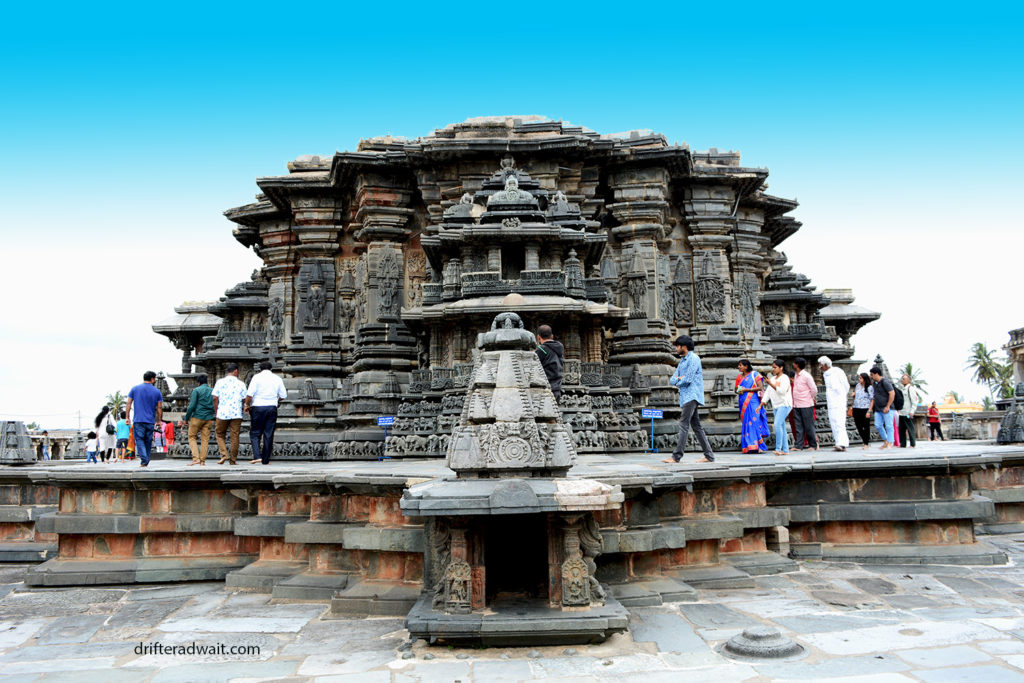
A small town, just like any other town in southern India. Dusty, crowded streets buzzing with the street vendors, agriculture shops, tractor showrooms, and some Udupi restaurants surrounding central bus stand. Adjacent to National Highway 73, located on the southern shore of the Yagachi reservoir, Belur is a home of one of the most brilliant architectures ever created in history. Channakeshava Temple.
Hoysala Empire History:
Hoysalas were one of the respectable families in southern India, from a village named Malenadu. Initially, they were serving the Western Chalukya Dynasty during the early 11th century. Taking the advantages of the constant clashes occurring between Chalukyas and Kalachuris in southern India, Hoysala rose to power.
Hoysala dynasty has a rather interesting origin story as per the local folklore. In the 11th century, there was a Jain teacher sage named Sudatta, living in the village of Sosevuru with his few students. Once, a gigantic lion attacked his Ashram while he was teaching. Sudatta ordered his student Sala to slain the lion. Without any hesitation, Sala picked up the sword and after a horrible battle between man and the beast, he killed the lion. In old Kannada, Hoy means to Slay. Hence, the Dynasty Sala established was named as Hoysala. This emblem will be found on stone inscriptions, on the temple walls as well as on the turrets of the temples belonging to the Hoysala dynasty.
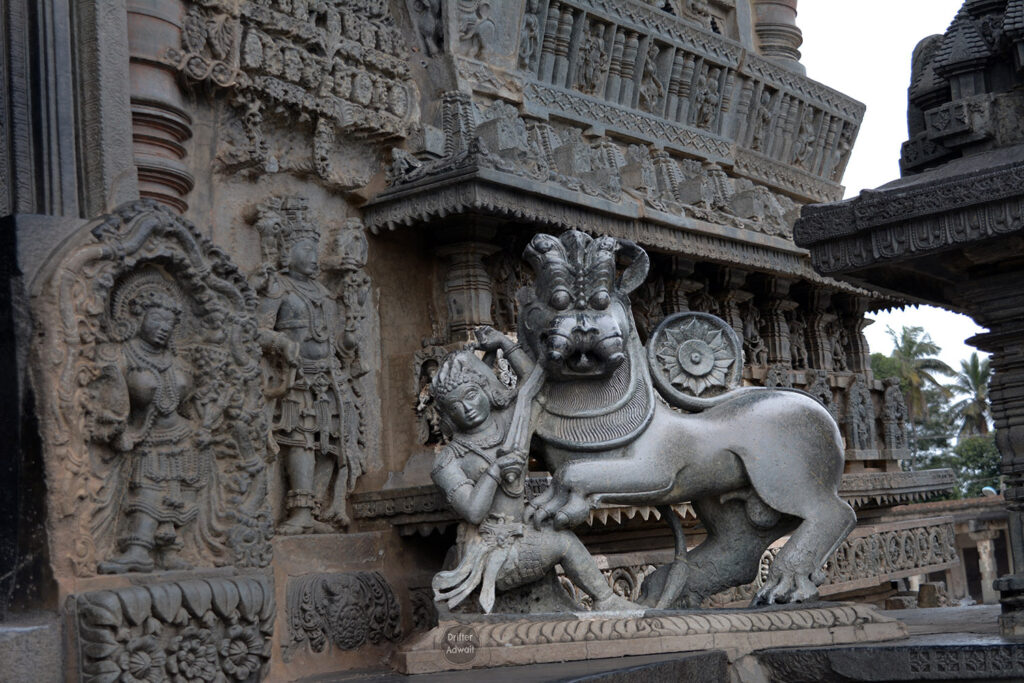
Many inscriptions are found praising the Hoysalas, from Solapur to Tanjore and from Kodagu to Arcot. Many brave Kings like Sala, Ballala, Narsimha, and Vishnuvardhana ruled here with honesty, empathy, and wisdom. They fought many wars with Kadambas, Pandyas, and Cholas to expand their territories. Initially, they have capital right here at Belur. Later, they moved it to Halebeedu. For a while, even they tried to stop the Islamic invasion, coming from the north. But after a while, they could not match the brut ferocity of Malik Kafur. in 1311, on his second invasion of South India, he raided the Hoysala Kingdom, looting, Killin, raping and burning anything and everything in his way with a force of a hundred thousand riders. He halted at new Capital Dwarsamudra, for twelve days, so that he can peacefully burn the city and destroy the Halebeedu temples with Hammers. And everything was destroyed as per his satisfaction, he returns to the North.
Chennakeshava Temple
Legendary Architecture Historian James Fergusson describes Belur as, “It may be probably considered as one of the most marvelous exhibitions of Human Labor, to be found in the patient east. No two facets of the temples are the same, every evolution of every scroll is different. No two canopies in the whole building are alike and every part exhibits joyous exuberance of fancy scorning every mechanical restraint”.
History of Chennakeshava Temple, Belur
As per the various inscriptions, found across Karnataka, within the span of 350 years, Hoysalas built more than 1500 temples. They made Velapuri their capital. Due to their devotion towards Lord Vishnu, Velapuri (Belur) was received admiration as Dakshin (Southern) Varanasi, and Vaikuntha on Earth.
This great monument of medieval art was built by King Bittideva, who called himself Vishnuvardhana. Bettideva initially was following Jainism. But after coming under the influence of Sage Ramanujacharya, he transformed himself as Vaishnav or the one who follows Vishnu. He had glorious military campaigns during his regime fighting alongside his general Punisa. After his spiritual enlightenment, he went on war and had a huge victory over Cholas in the war of Talakadu. To celebrate his victory over the Chola dynasty, he and his beloved queen Santala Devi started the construction of the temple. Hence, this temple is also called as Vijaya Narayana Temple. After 130 years of meticulous construction, this marvel was erected. His grandson, Veerballala II added many sculptures to it, later on, completing this masterpiece.
After the invasion of Malik Kafur, Belur was decimated to the ground. In the 14th century, Vijaynagara kings reconstructed the temple, with some more additions.
In 1433, one Iraqi traveler named Abdul Razaq visited the temple. He was so impressed with the marvelous architecture, he just writes this in his journal: “I dared not attempt any description, or I will be accused of exaggeration”.
Chenna means beautiful. Kesava is one of the thousand names of Lord Vishnu. Chennakesava means Gorgeous Vishnu.
Chennakeshava Temple Architecture

Hoysala temple has some unique distinguishing characteristics. Usually, these temples will be located near a water reservoir. They all will be constructed on elevated platforms, and the walls will be constructed in such a way that the maximum number of sculptures can be added to them. Chennakeshava is not different from it. Hoysala style of architecture is a perfect blend of southern as well as the Northern Indian style of architecture. Best of the two worlds. First, you will be greeted by the Raj Gopuras. As you cross them, flag pole and Garuda in Namaste pose welcome the devotees. Then, you will find yourself in front of the main temple, elevated on a star-shaped platform. This temple has two sides. Front and back. The front side has been called a Jeevatma side, as it represents every day from our normal materialistic life. The entire Jeevatma part of the temple is underscored with beautiful figurines in female form, fixed with brackets on the roof. These women or Madanikas are inspired form queen Shantala.
The backside is referred to as Parmatma or, divine. Brilliantly beautiful sculptures of Gods, Goddesses, and other holy beings are chiseled here.
Gopuram of Chennakeshava Temple:
Temple is surrounded by a huge wall, protecting the temple. By using the same sturdy walls, corridors with small rooms are constructed from within. The entrance is decorated by a huge yellow Gopuram (Tower), which is visible from anywhere within the town. Hoysala king Immadi Ballala built the original Gopura during 1200 AD, but it was destroyed by Bahamani invader sultan Shamshuddin Shaha. The Gopuram and the wall you are seeing are built in 1397 AD by Vijaynagar kings. Hence, this Gopuram resembles the Gopuras from Hampi temples like Vitthal or Virupaksh temples. Remove your foot ware on a stand and enter through the grand entrance. Hire a guide, he will be worth every Rupee. You will find yourself standing in a huge courtyard, keeping ChannaKesava temple in front.

Gopuram structure is the specialty of South Indian temple architecture. Gau means cow, or holy in Sanskrit. Puram means town. Hence, gopuram means Holy Land. You can see two cow horn-like curvey structures are set on the top of the tower, naming the tower as Gopuram. Representing the holiness of the place.
In between two horns, you will find five decorative brass pots or Kalasha like structures. Number five has a special place in Vedic religion. Number five dominates human life in many ways. As per Vedic texts, there are five elements (Panch Bhoota as in earth, water, fire, air, and space), there are five senses (Panchendriyas, as in sound, touch, sight, taste, and smell), five Sacraments (Panchamrut), Five products from Cow (Panch Gavya as in milk, urine, dung, curd, and Ghee), five lamps to be offered to Lord Vishnu (Pancharati), Five Vedas and last but not least, Five Pandavas as well.
Pole of the Garuda
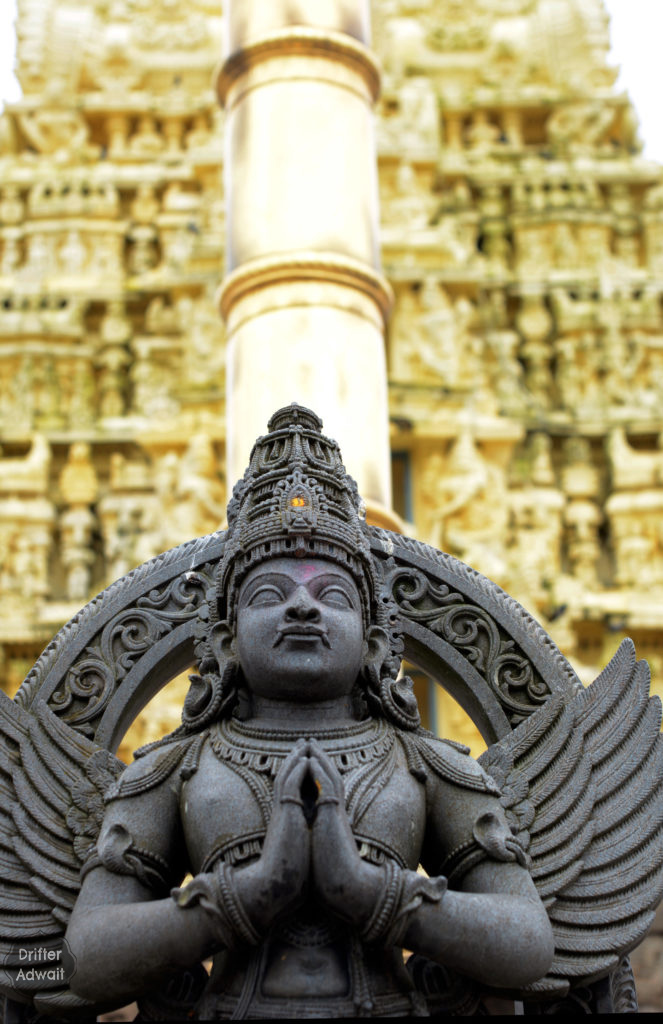
There is a twenty-two-foot brass flagpole, right in the middle of the temple courtyard. During the festival of Brahmotsava, Garuda, the eagle flat is hosted on the top of the pole. The presence of a flag pole with Garuda statue represents the completion of the temple, inviting the devotees.
Garuda idol is kept in front of the pole. Garuda is a demigod, god of all the birds, is standing here in front of Channakeshava, in Namaste position. The statue is loaded with jewelry of exquisite carvings. Lord of birds is wearing arm-bands and wrist bands made up of Cobras, along with a beautiful ornament called Mekhala, under his stomach, adorning his thighs and Hips.
The statue is, however, established a few centuries after the Hoysala Period by the sculpture named Javaracharya.
Temple Surroundings
The main temple is surrounded by several mini shrines, a well-built water tank, one ceremonial hall, one giant gravity pillar, a granary, and roofed corridors with stone pillars running across the fence wall.
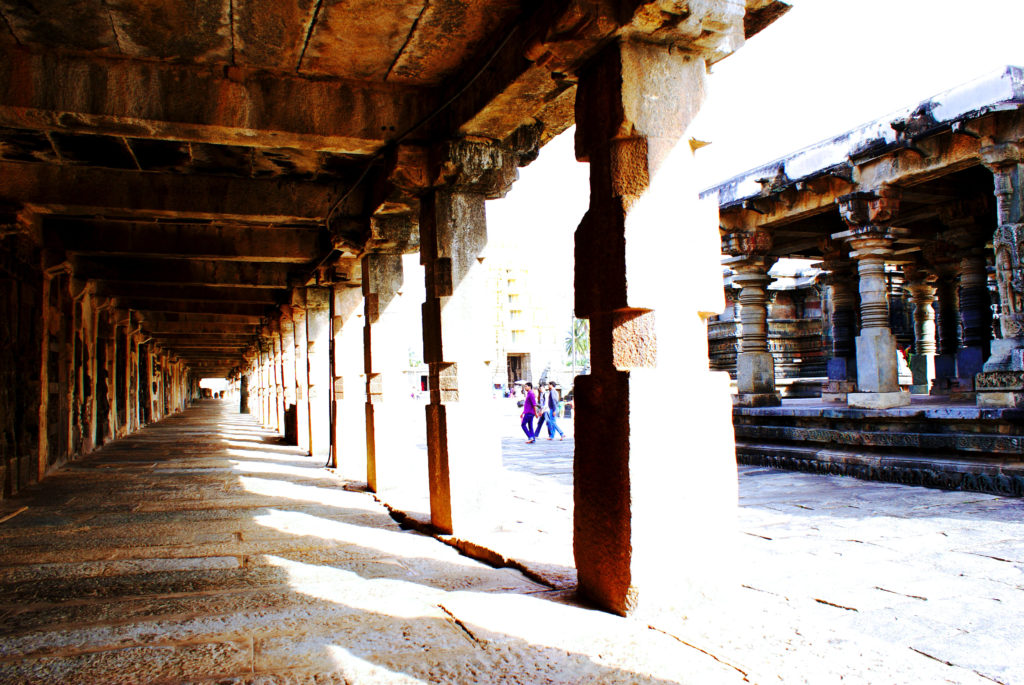
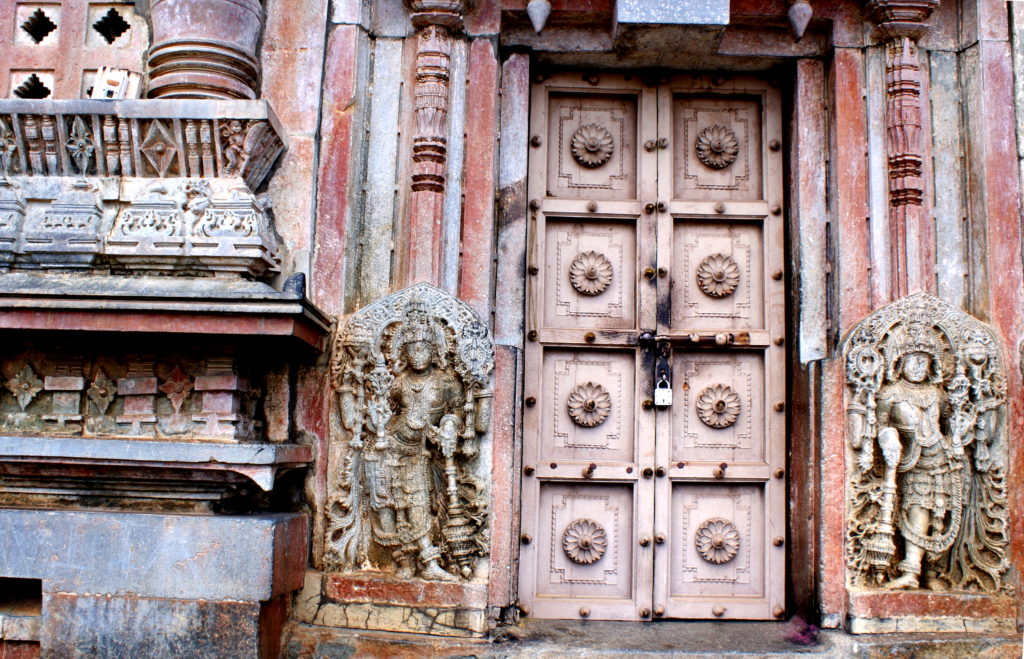

Don’t be in such a hurry to climb those steps to enter the main temple. There are four mini temples on each side of these steps. Tini tiny elephants are carrying these four mini temples on their backs for centuries.
Chennakesava Temple Entrance

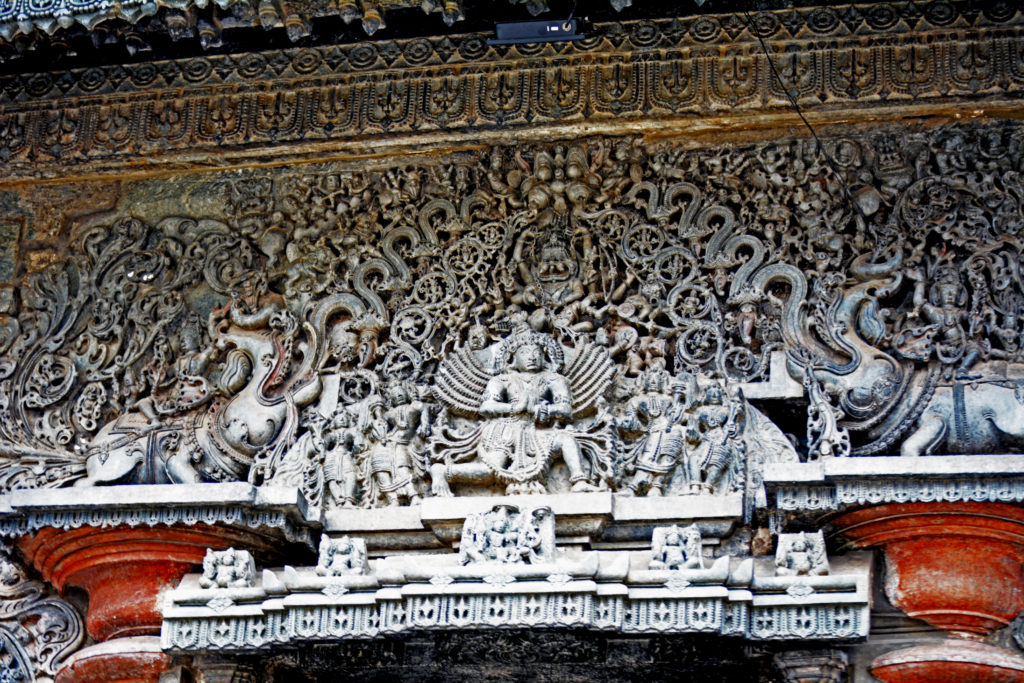
Before entering the temple, spend some time observing the east-facing entrance. A skillful, ultra minute craftsmanship is ornamenting the entrance. The symmetry is just astonishing. Makar animals, saluting Garuda and Narsimha on top while Kirtidhwaja looking over them. Narsimha is wearing the intestines of HiranyaKashyapu like garlands. Look close enough, you will see ten incarnations of Lord Vishnu hidden inside the circular creeper bordering the Narsimha. Rest is just a stone coming to life, like ripples on calm water. Hoysala kings were Vaishnav (followers of Lord Vishnu) and their clan god was Narsimha. Here, you will encounter this ghastly demon slayer god in many forms.

Kama and Ratee are considered as celestial gods of desire, love, lust, passion, and carnal pleasures. They greet you at the doorsteps of Chennakesava temple, reminding you to get rid of such desires if you want to meet the Parmatma. Leaving the lusty desires outside the temple, you enter the structure.
Entrance Bay
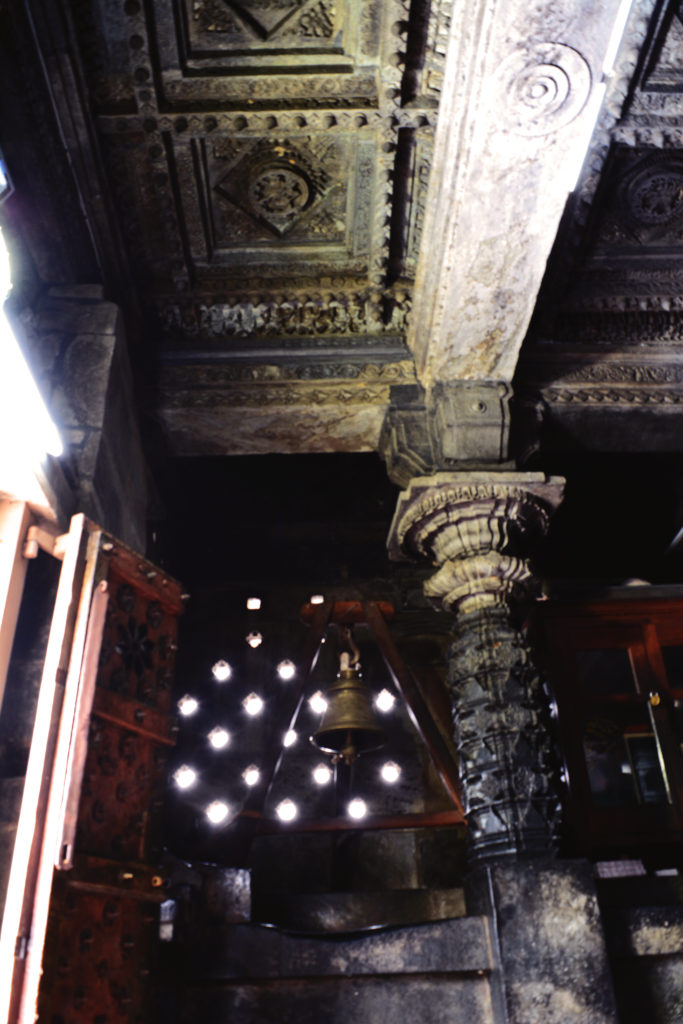
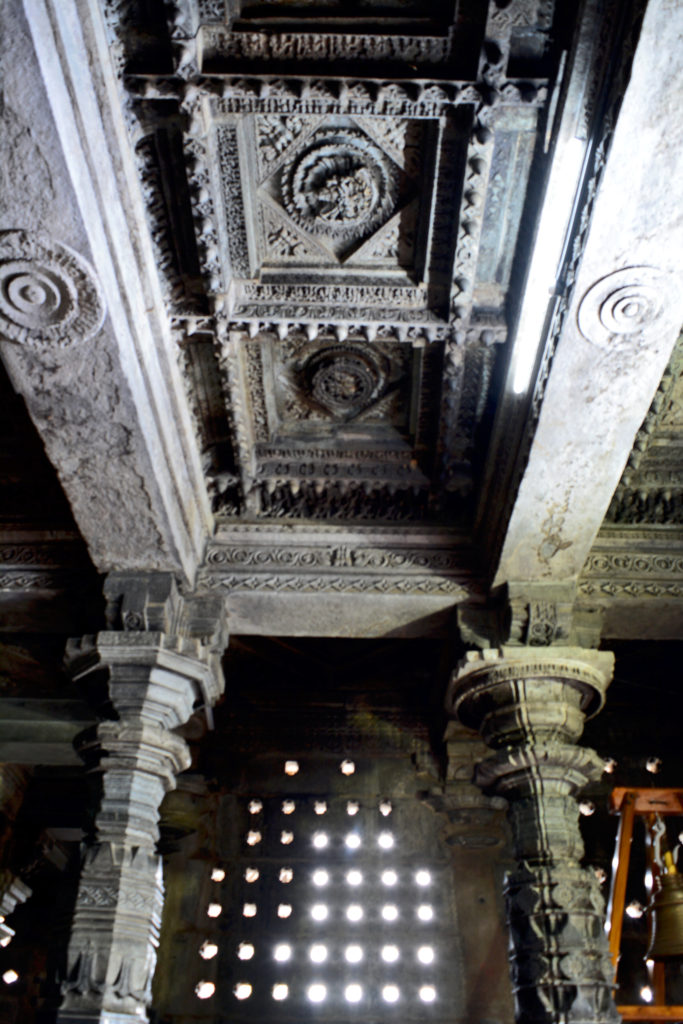
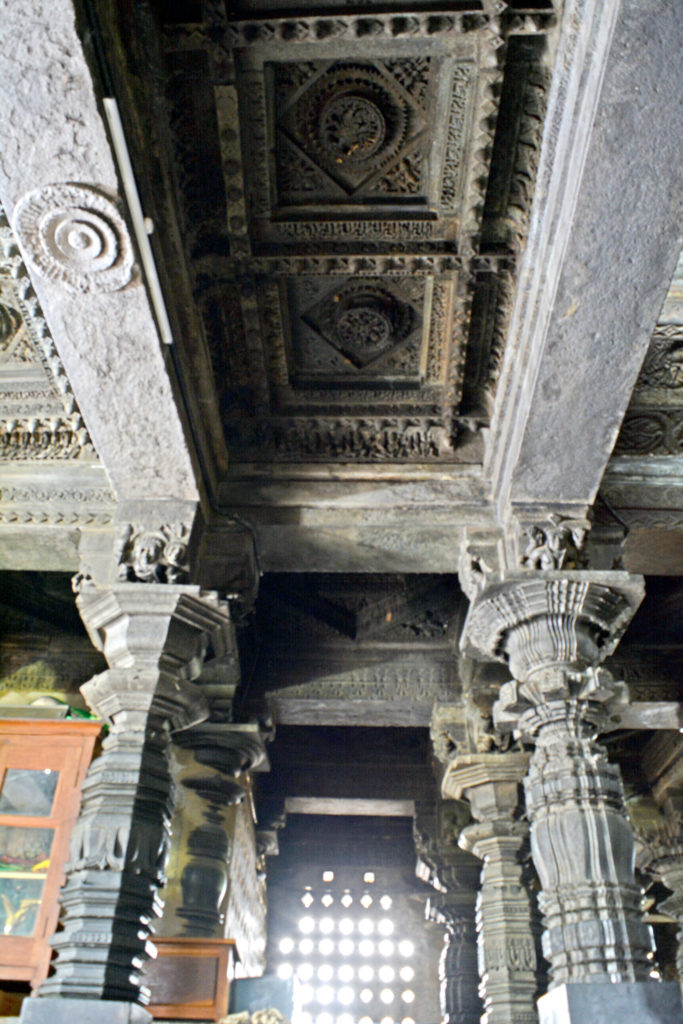
Its dark inside, so be careful not to bump into one of these lathe-turned pillars carrying the main temple. Their edges are sharp like swords. How they have carved them so sharp and accurate? Don’t know.
Each pillar has a different story to tell. Belur temple roof is held on top of 48 pillars. Some of them are smooth circular in shape, some of them have lotus, stars, and umbrella carved on them. But, two of them, stand out the most.
Narsimha Pillar
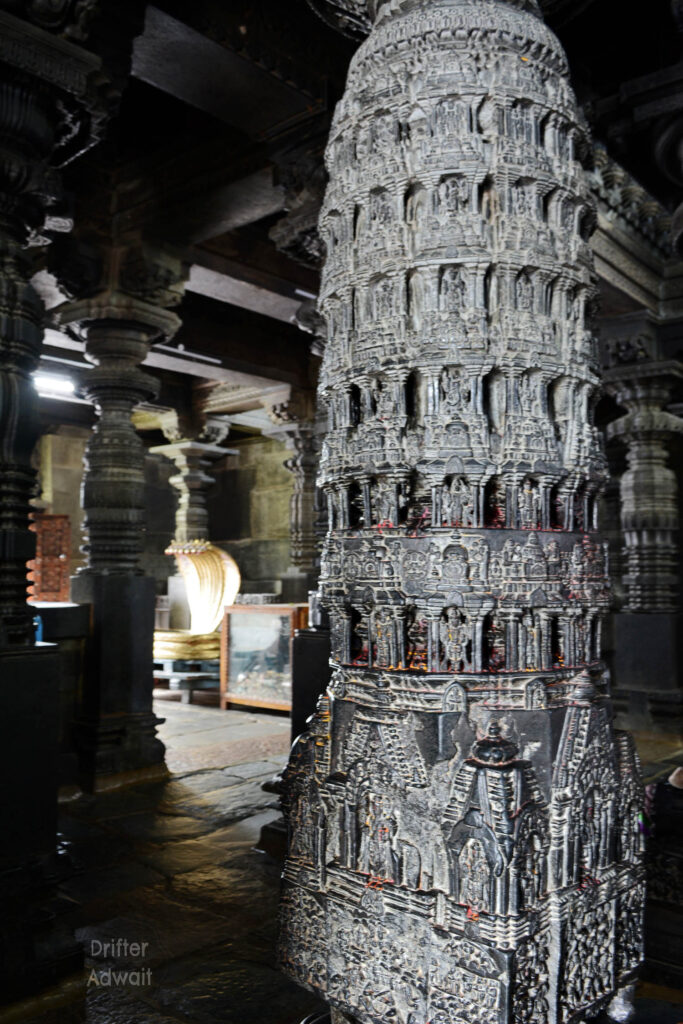
It uses to rotate around its axis
There is one pillar named Narsimha pillar, which is said to be revolving with the help of ball bearings, once upon a time. as the time passed, the ball bearings inside got damaged. Narsimha pillar portrays the idea of heaven with several floors. Each floor has small pillars, which are hollow from inside. I think these sculptures are just showing off to the gods what they can create with the stones. Different gods, deities, and other celestial creatures have been portrayed on the pillar. The entire pillar is filled with minute craftsmanship, except for one small square. This square represents the almighty God, in his formless characteristic. Some sects in Hinduism believe god does not have shape, size, and any definitive form. This blank square represents the formless god. Guides in the temple believe, that it was left blank intentionally, to challenge the future generation of sculptures.
Mohini Pillar

Same story with the famous Mohini pillar. The female incarnation of Lord Vishnu is beautifully carved here, presenting the perfect female form. She is called Kamakshi, the one with hauntingly beautiful eyes., with a narrow waist (Simha Kati). She has shown wearing a sacred thread- A Janeu, underlining the equality in ancient India, where women had equal rights as men. Her hips are decorated with an ornament called Mekhala, and one garland, which is coming over her shoulder, till her knees is called Vanamala.
Bhuvaneshwari: Decorative Ceiling
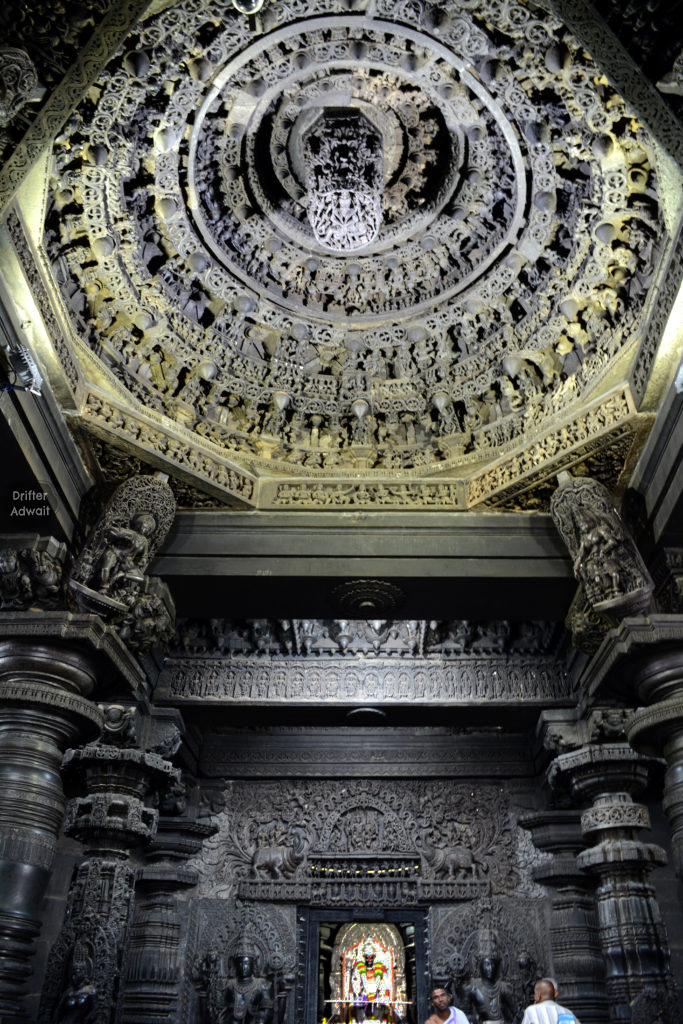
Now, comes the best part of the temple. Its roof. Right in front of Sanctum, there is a round platform of six inches height. It is said, that queen Shantala used to perform her dance here on auspicious days, to honor the Keshava. Right above this ancient dance floor, there lies the best roof in the world. Forget the Sistine Chapel from the Vatican, painted by Michelangelo. This is carved over your head. Most intricate design, on the inverted dome, is the silent feature of Hoysala architecture, presented here in the most beautiful manner. This design has an appropriate name as Bhuvaneshwari. These are 52 soapstones, interlocked with each other, without any cementing material.
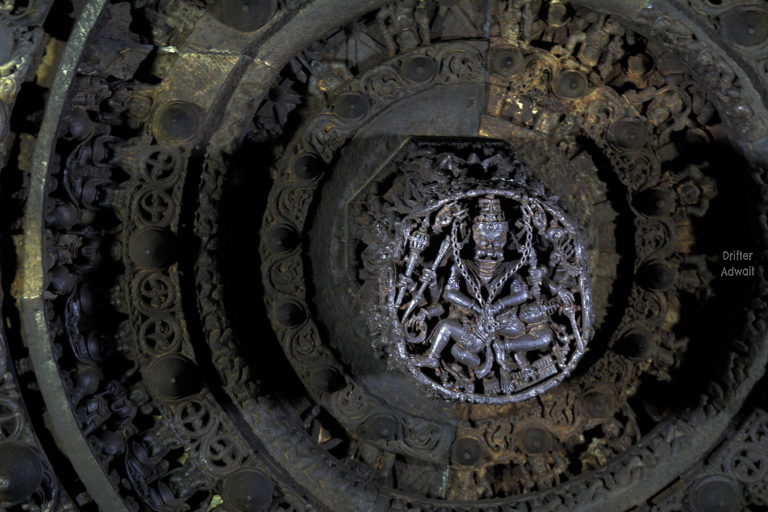
If you look closely on your head, you will find a small intricate carving of Ugra Narsimha, slaying the demon Hiranyakashipu. Narsimha is tearing the demon’s stomach and wearing his intestines as the garland, around his neck. He has ten hands, and in remaining hands, he is holding various weapons. This Chandelier made up of stone is the highlight of the Belur temple.
The most beautiful, intricate entrance in the world, carved out of black stone, and not from white marble…
Torana (Entrance Border of Sanctorum)

This is perhaps the most intricate stone carving I have seen in my life. On the door border of the Sanctum Sanctorum of Chennakesava Temple. Lord Chennakeshava, is guarded by horrifying Jay-Vijay. They are covered with some seriously minute detailed, laser-cut, exquisite Jewelry. Detailing will just blow your mind. These two doormen of Kesava are loaded with such a finest jewelry that I have not seen before.
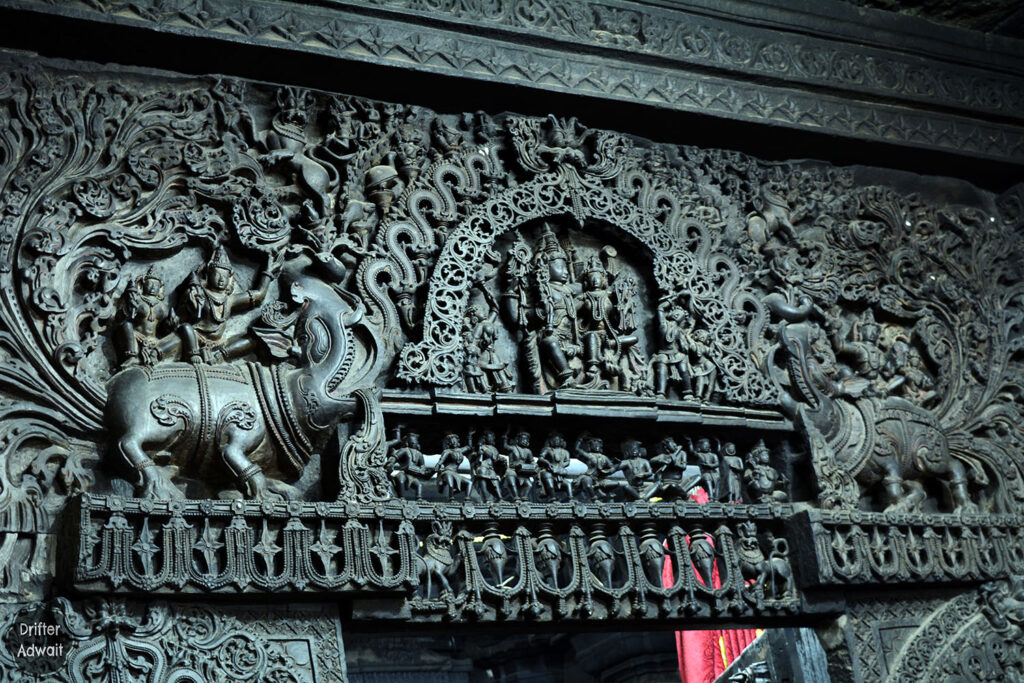
On the top of the Jay Vijay, you will see some epic craftsmanship indeed. On the crowned heads of Jay and Vijay, you will see Makara animals. These celestial animals are a combination of several ferocious creatures from the animal kingdom. Riding on them, are Varuna and his consort Varuni. The lord of the rains and prosperity. One of the legendary Ashta Digpalas, protecting the west direction. They have tails like a peacock, creating waves on the stones. A border coming out from their mouth is escalating towards another fierce creature called Kirtimukha. These waves have their own fold, and each wave has five folds. On each fold, you will see a fish, a tortoise, Varaha, and so on. Each fold represents the incarnation of Lord Vishnu.
These waves, coming from the mouths of Makara have created an arch-like structure, under which, you can see, Lord Vishnu and Goddess Lakshmi are sitting.
Bellow them, you can see celestial musicians and dancers called Gandharva, doing what they are best-known for-Dancing and singing. Each of them has the body language of their own, all are praising Lord Vishnu with their heavenly music.
Bellow them, you will see five half blossomed inverted lotuses and Lions on their both sides.
Madanikas Surrounding the Dance floor:
Here, you might get that weird feeling that somebody has eyes on you…There is a soft spotlight right in the front of the main Garbha Griha. Once illuminated, you realize, that feeling of being looked was correct indeed. You were indeed surrounded by 4 amorous, beautiful celestial Nymphs, sitting on each pillar, teasing you, out of your reach.
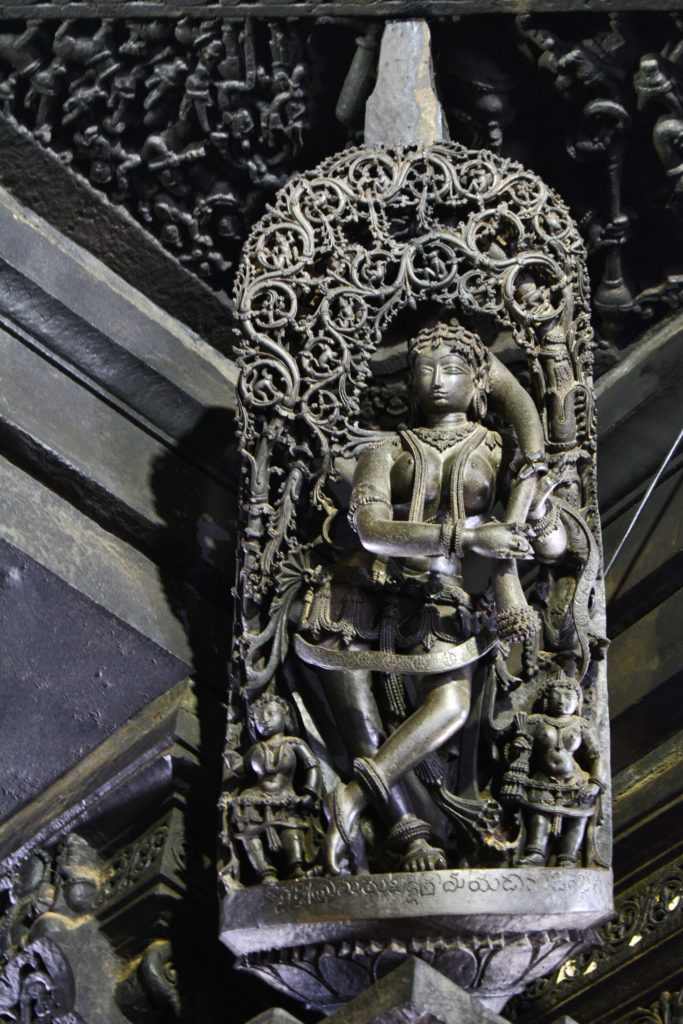
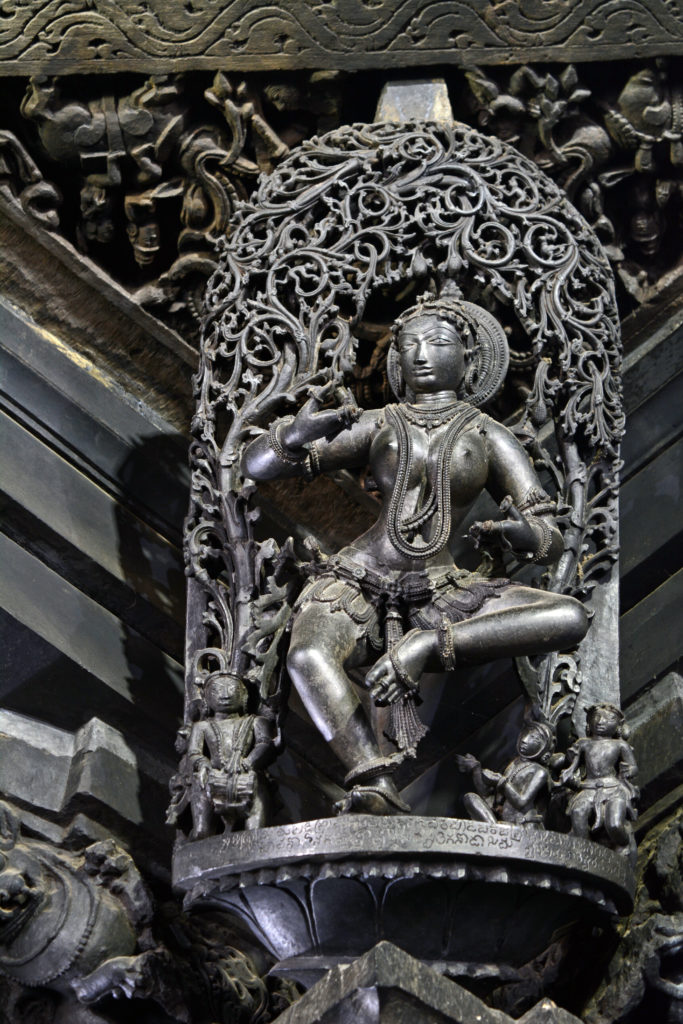
Here, Madanika 1 is trying to dry her long hair. You can see the water droplets accumulated at the bottom of her hair. Her two attendants are helping her to get ready. A creeper behind her is carved with tremendous intricacy. Taking a look closer reveals several monkeys and birds are jumping up and down on those branches of the creeper. At the bottom, you can see an inscription reading “Balligavi Dasoja” who was the sculpture of this beauty.
The second lady is none other than Queen Shantala herself, dancing on the beats of a drummer, presenting in front of Lord Chennakesava. “Chavana” was the name of the sculpture who kept the memory of this legendary queen alive. The sculpture has brilliantly carved the facial expressions, hairstyles, and body language of the queen here.
There are a total of 42 of these gorgeous women, spread across the entire temple. Dancing, singing, hunting, poisoning, drumming, dressing, observing their reflection in the mirror, and whatnot. It is said that they represent an ideal female form. Indeed they do.
Circumambulation of Belur:

As mentioned earlier, Hoysala temples are mostly built over a star-shaped platform. Parikrama path around the deity is decorated here, with the highest degree of imagination, devotion, and artistic vision. There are almost 600 sculptures to be found on these walls, out those, 80 are missing.
Once you get out of the main temple and start circumventing, you slowly start to realize something. You have to stop each and every foot. This temple is not to be taken lightly. You need at least 2 days, to absorb the beauty of sculptures, carved on the walls of the main temple itself.
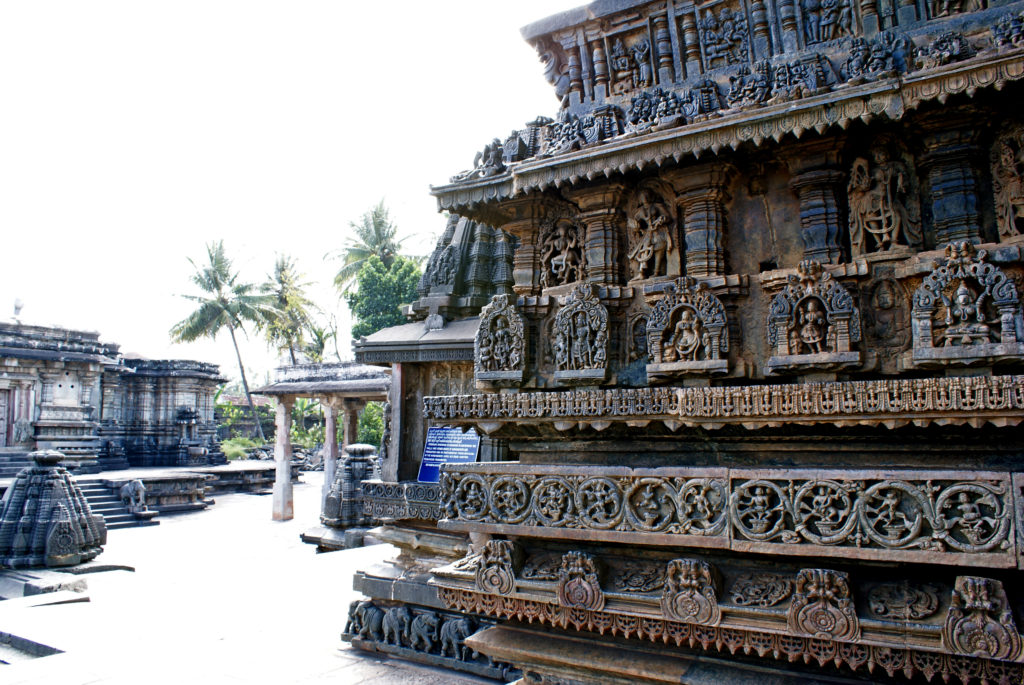

There is not a foot of space left blank on the outer walls. The entire temple is made up of small layers. On the base layer, there are hundreds of -one feet elephants. Lions on top of that, and horse riders on top of those. It is confirmed that not one of these hundred tiny sculptures is repeated anywhere in this temple. Meaning, among these hundreds of elephants, no two elephants are the same. On top of that, there are these poster-sized sculptures of different Avatars of Lord Vishnu, Brahma, and Lord Shiva, overlooking them.
The elephant layer represents the strength and stability of the Kingdom, while the horse layer represents the swiftness of the soldier on the battlefield. In between these two, you will find a layer, made up of lions, representing the valor.
The entire temple is built with soapstone with an interlocking system. No cementing material is what so ever anywhere. This means, the entire temple can be dismantled and can be erected once again, somewhere else.
The sculptures you should not miss at Belur:
Gajasur Samhara

Lord Mahadev, answering the call of his devotee, as he always does, arrived at Kashi and started a war with Gajasur the torment. In the middle of the fight, Gajasur increased his size and swallowed Bholenath. Immigietly, Mahadev started his famous celestial dance – Tandava, inside his stomach, opening the demon from inside. Just before dying, Demon Gajasura apologized to the Bholenath and requested to wear his skin as a cape. Bholenath being Bholenath, accepted the brave demon’s request. What you are seeing here is a brilliant masterpiece. Mahadev is holding many weapons in his hands, while his remaining three hands are holding the heavy elephant skin upwards. He is dancing on the elephant head, while his thin to bone disciples, Gunas, are praising him.
Varaha
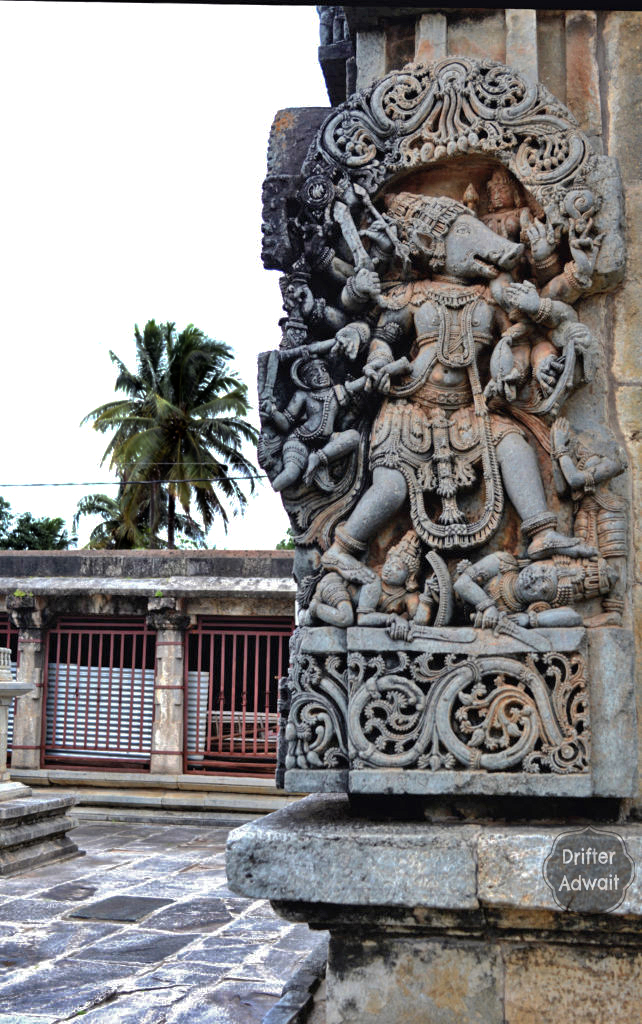
Everyone knows how Vishnu in the form of wild boar Varaha, saved the earth from the grasps of Demon Hiranyaksha. Here, in Belur courtyard, it has been depicted rather marvelously. You can see, earth, in the form of Bhu devil, sitting on the strong shoulders of twelve handed Varaha. He has a powerful snout and bore fangs coming out of them. Beneath his feet, you can see demon Hiranyaksha, holding the sword. Due to the enormous weight of Varaha, the demon’s eyes are bulging out. He is shouting in pain with his demon teeth out.
Ugra Narsimha
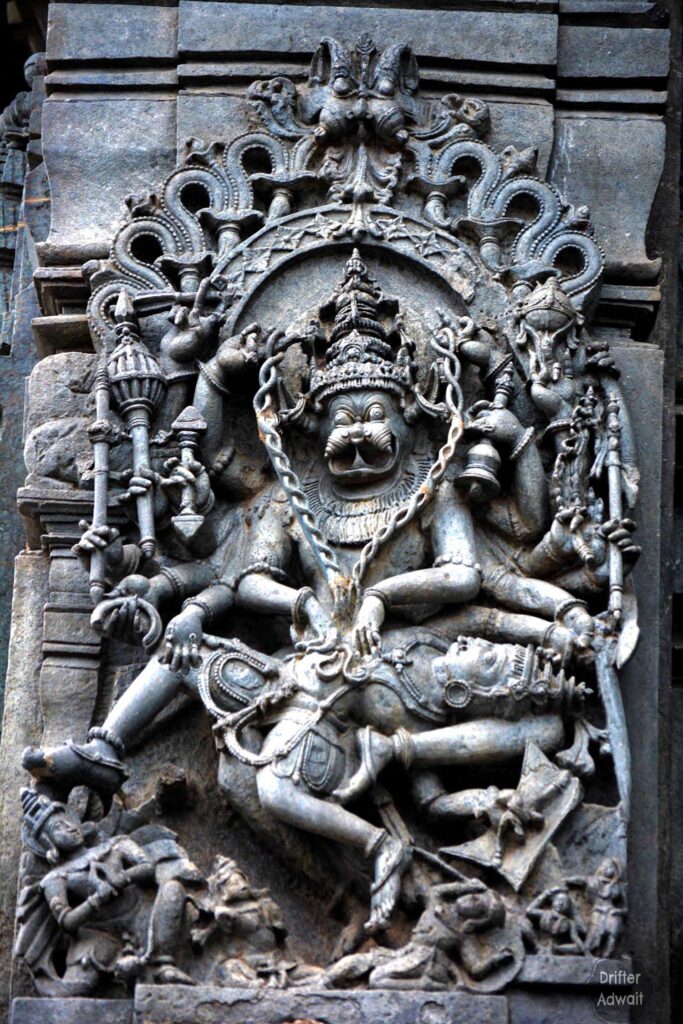
It’s one of the most ferocious sculpture I have ever seen. Demon Hiranyakashipu is on the lap of Narsimha. The demon is shouting in pain as his stomach is being stored by the sharp nails of Narsimha. Sixteen handed Narsimha is holding various celestial weapons along with his beloved conch, mace, disc, and lotus. His eyes are bulging out with extreme anger. In anger, he has removed the intestines from the stomach of Hiranyakashipu and, he is wearing them like some garland. Beneath his feet, you can see Garuda and Prahlada, saluting him, praising him to calm down. What an imagination.
Brahma and Surya
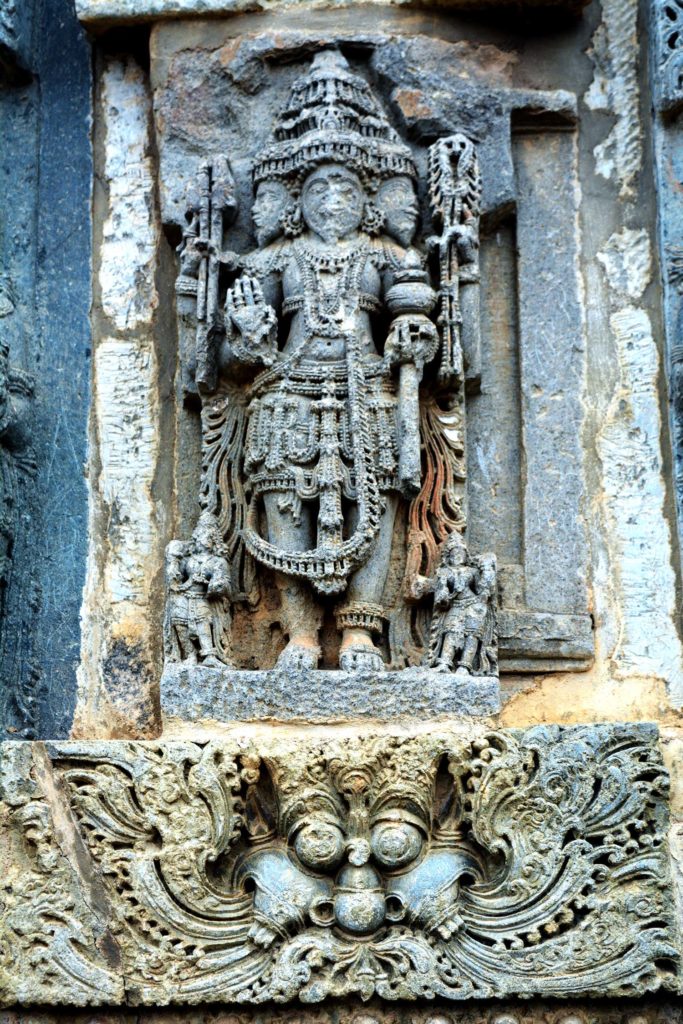

On left you can see three-headed Brahma, standing on Kirtimukha face. On the right, you will see Surya (Sun), riding on his chariot of seven horses. These seven horses represent seven days of the week. His chariot is being driven by his driver Aruna.
Bheema fighting Bhagadatta

On the walls of Veer Narayana temple, which is at the backside of Chennakesava temple, you will find this brilliant masterpiece. Here, the fight between Bhagadatta and Bheema is sculpted in two steps. In fist, they have shown Bhima is getting trapped in the trunk of the elephant named Supratika of Bhagadatta. After his narrow escape, he is bouncing back, literally, on the Bhagadatta, sitting on the back of his legendary Elephant.
Gowardhan Giridhari
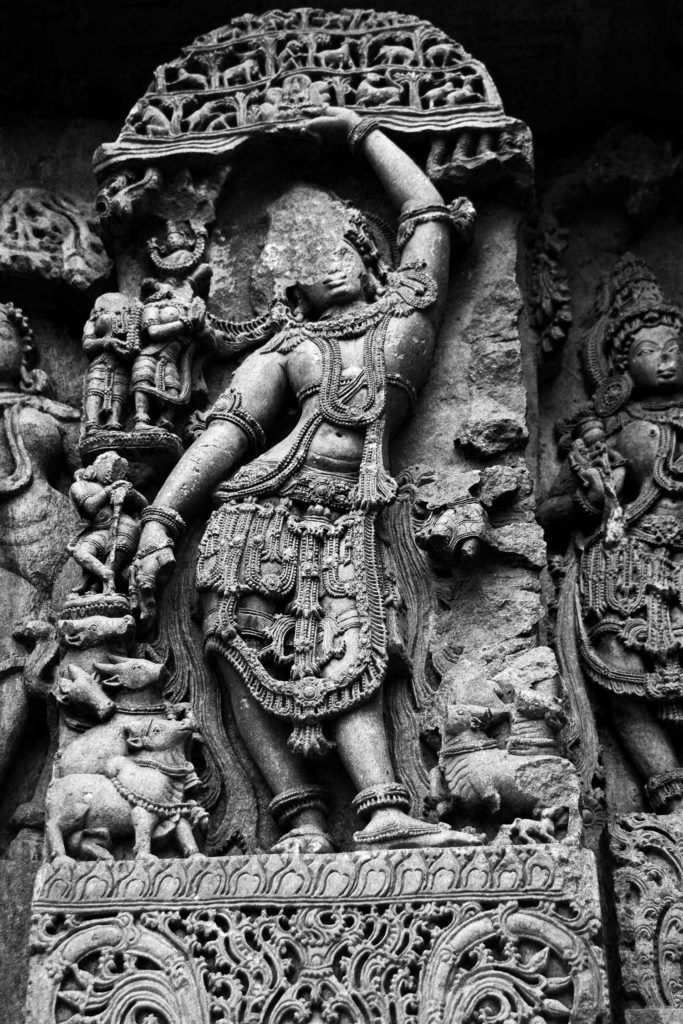
Here, Bhagwan Krishna is holding Govardhan mountain over his head with his left hand. You can see, lifting a mountain is nothing for him, as the way he is standing in a relaxed position. A careful look at the mountain will reveal the tiny details of the sculpture. You will see wild animals and trees, loaded with fruits and flowers on the mountain. Cows are gathering beneath the mountain, seeking the shelter, to be saved from continuous rain on Gokul. Cow herder is standing above the cows, railing on his staff. Residents of Gokul are praising Krishna for saving them from the wrath of Indra.
Saga of Vamana
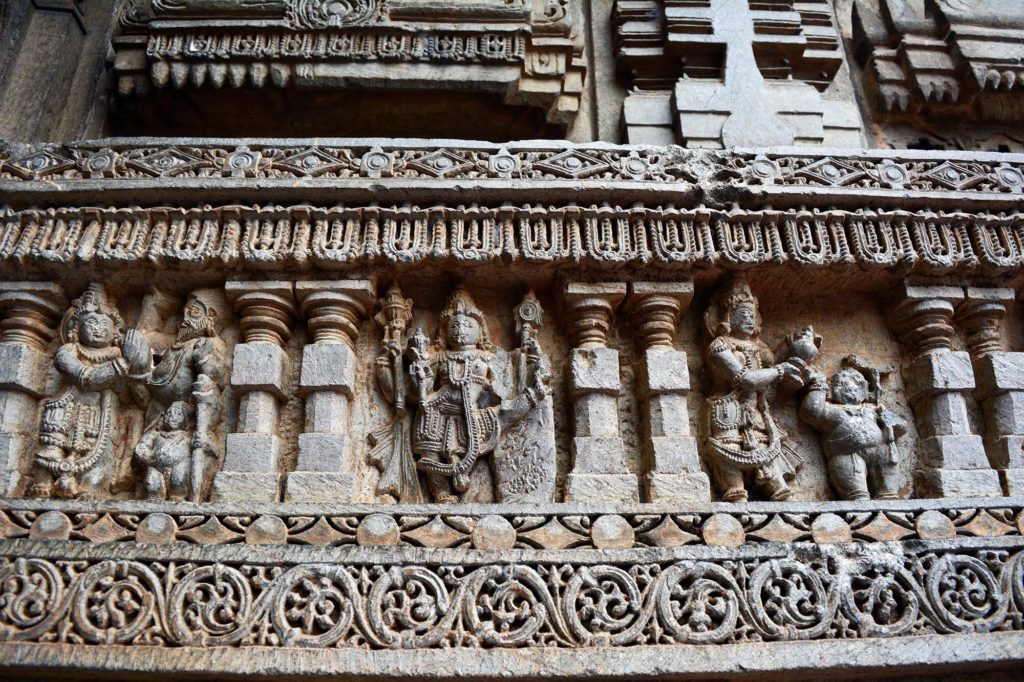
This is one of the miniature sculptures I found on my 3rd tour of Hoysalas. On left, you can see Legendary Demon King Bali, the lord of all worlds. He is saluting his teacher sage Guru Shukracharya. Besides Shukracharya, you can see a pot-bellied dwarf named Vamana, holding a long staff.
On right, you will see King Bali, pouring the sacred water from the kettle, officiating the giveaway, in front of Vamana. In the middle, you can see Vamana, in his Trivikrama form, occupying heaven in one step.
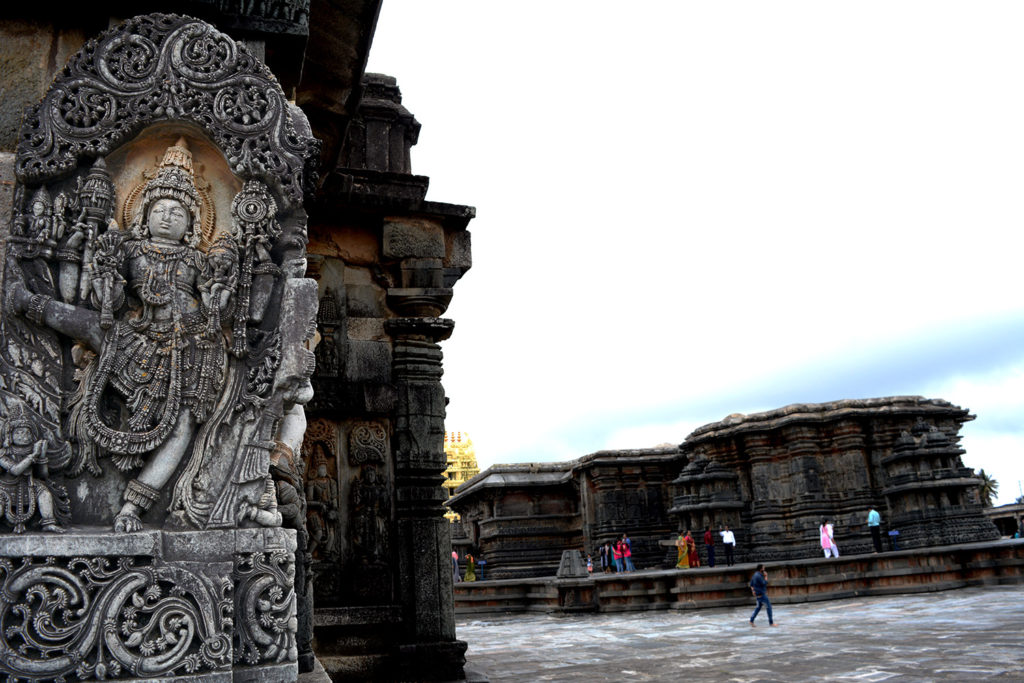
This idol is holding a mace, disc, lotus, and conch. If you are here with me till now, you know, that this idol belongs to Vishnu. After Bali giveaway three steps of land to dwarf Vamana, Vamana started expanding. In the first step, he occupied the entire heaven. This particular form is called as Trivikrama. Here, Vishnu is ready to take his second step. While doing so, his feet have reached Brahmalok. Brahma is pouring water on his feet, praising him. As Brahma is pouring water, the river is generated, You can see, stream, starting from Vishnu’s feet is getting bigger and bigger. If you look carefully, you will see fish, crocodiles, and turtles swimming in the river.
Sweet Sixteen and the Poison Girl
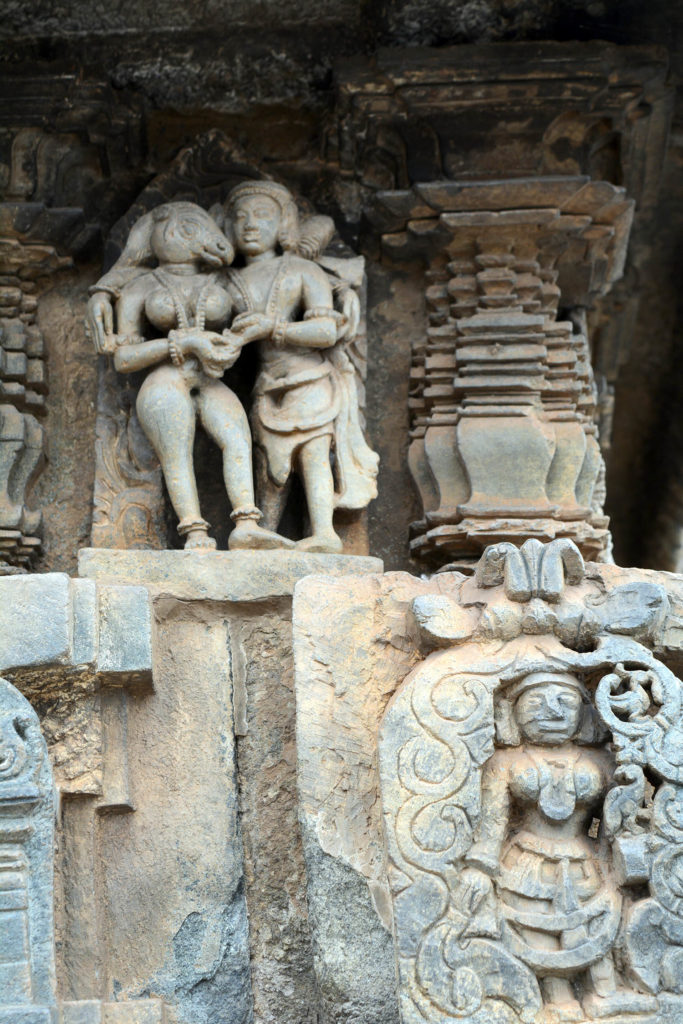

In the first pic, we can see a man, affectionately holding the hand of a woman, with the head of a donkey. In Sanskrit, there is a saying which goes something like this:
“Prapte Shodashe Varshe Gardhavi Bhavati Sundari”
Which means, sixteen years is a delicate, yet funny age. Even a donkey looks like a beautiful girl when you turn sixteen. This carving depicts a young man, fallen hopelessly in love with a young woman, with the brain of a donkey. But the real donkey is the young man, blinded by his desires.
In the second picture, you can see a beautiful woman, holding king cobras. In ancient times, while playing the game of thrones, often these beautiful Vishakanyas (Poison girls) were set upon to kill the King. That has been beautifully sculpted here.
Exam Ganesh

Students from Belur, pray to this Ganesha for passing grades.
It’s the most popular and busy Ganpati during April exam seasons.
Madanikas of Belur

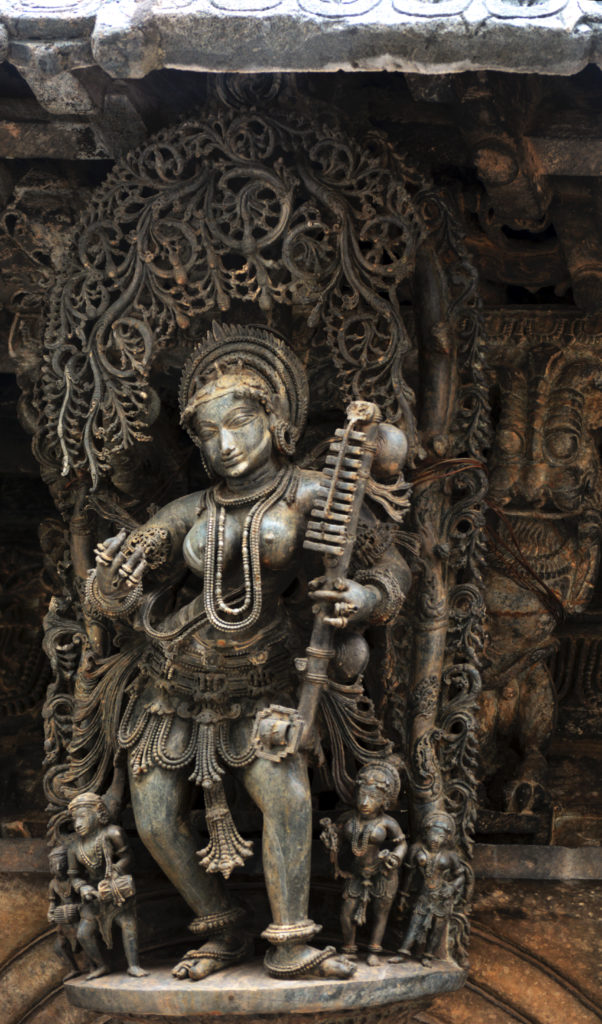
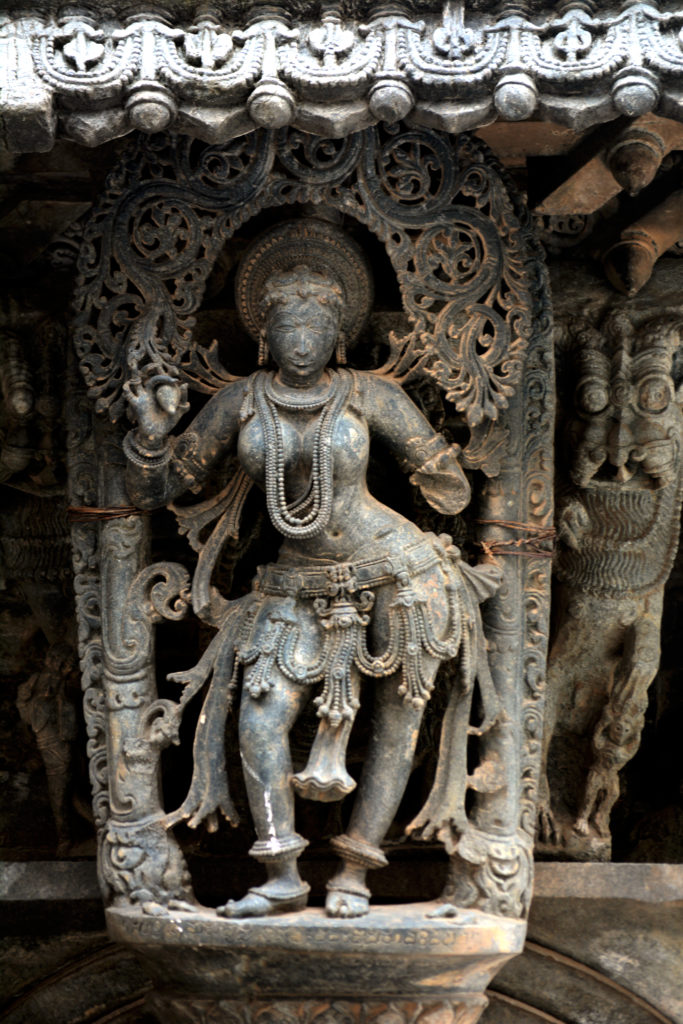
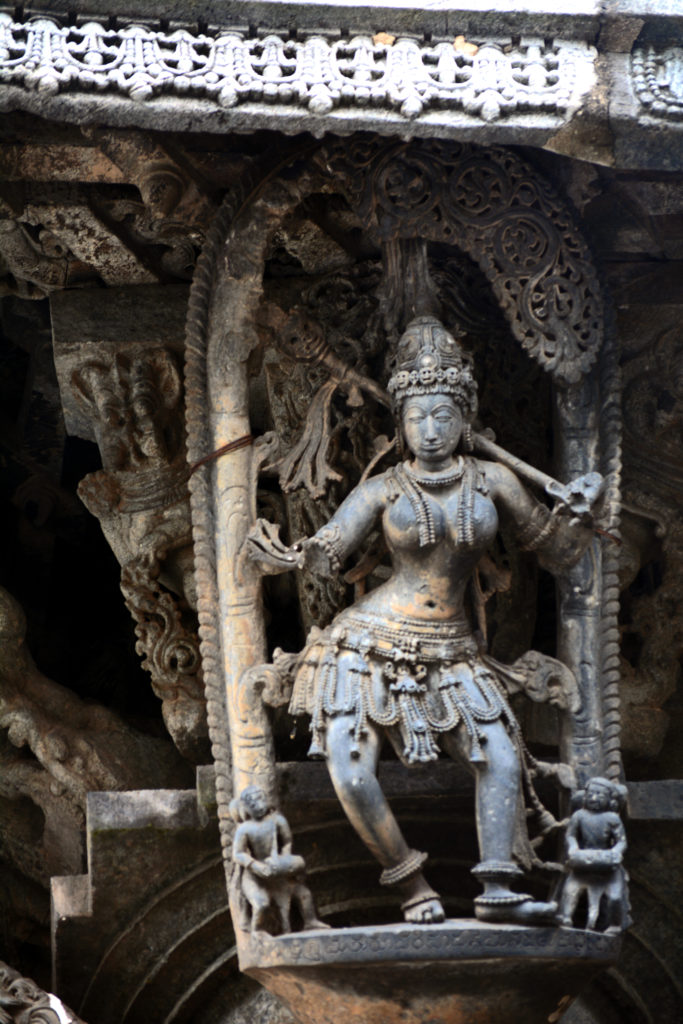
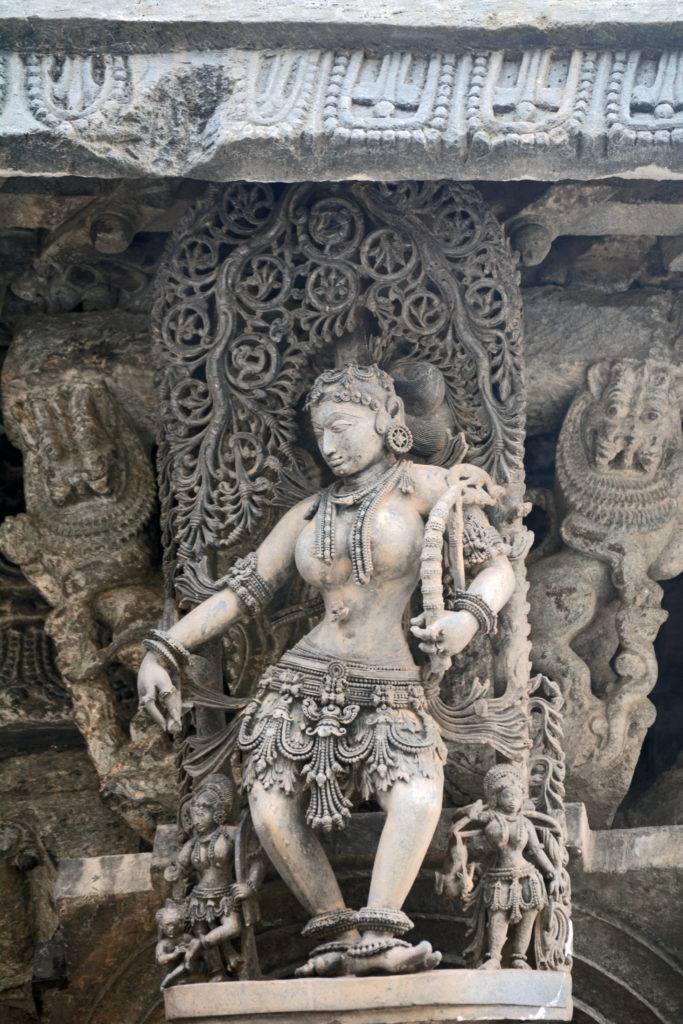
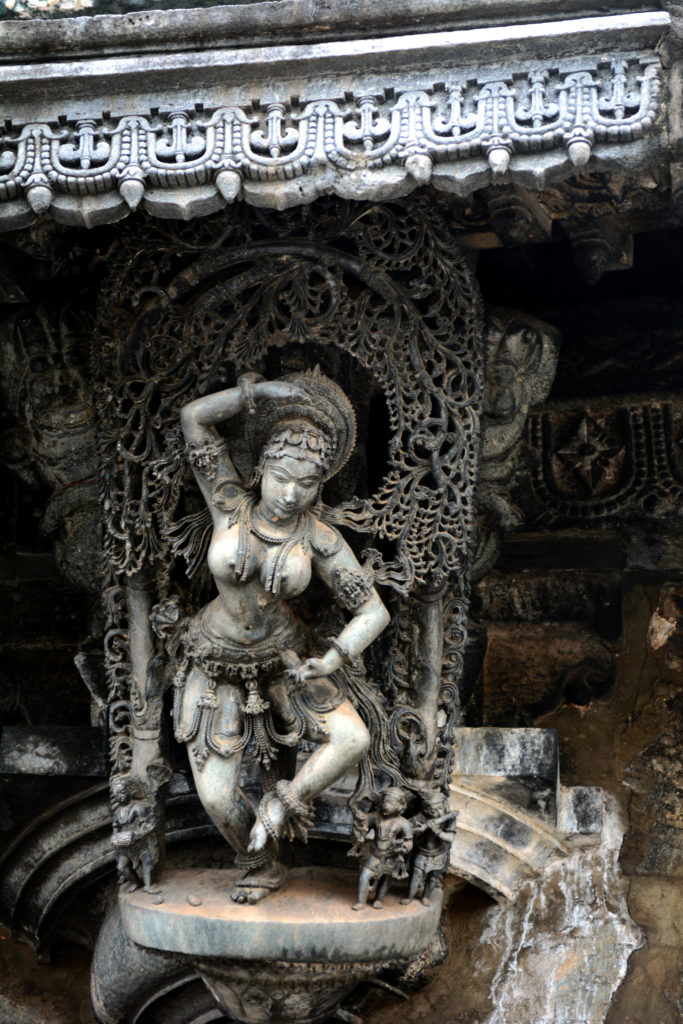
Ranganayaki Temple
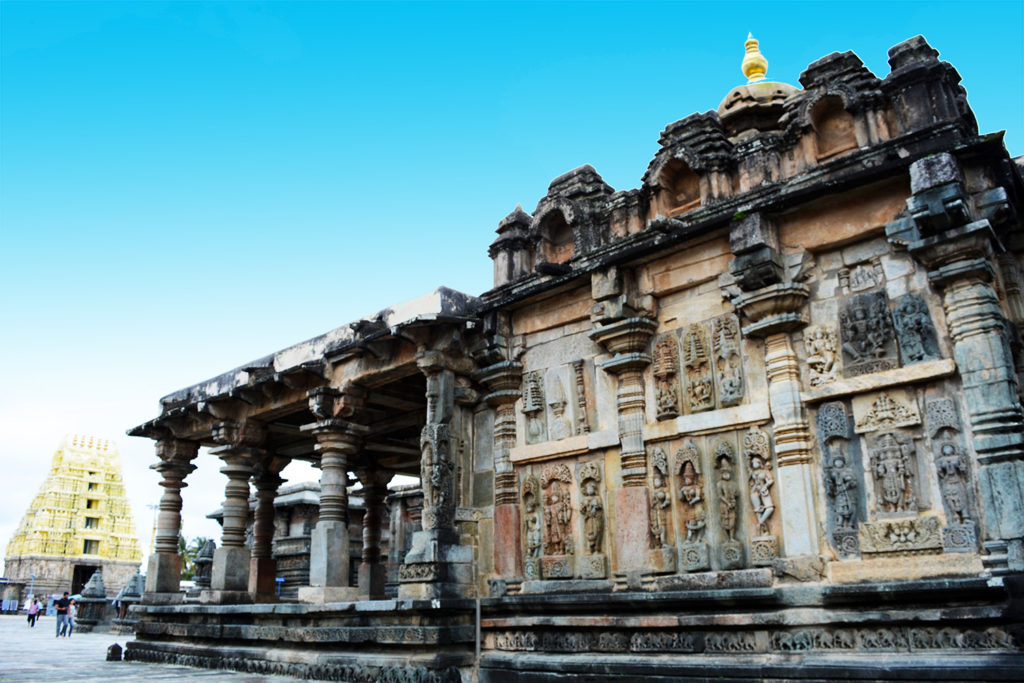
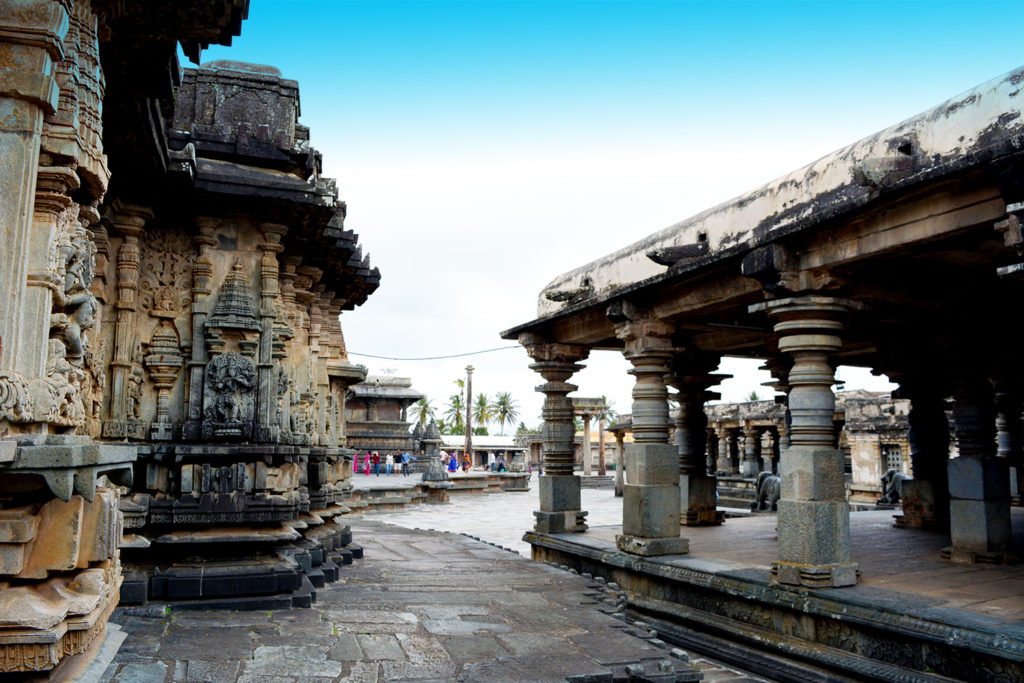
Located in the northwest direction of Kesava temple, Ranganayaki temple is one of the less explored buildings in the Belur courtyard. Unlike Chennakesava, it has a square-shaped platform on which tall walls have been giving support to many interesting sculptures for the last 800 years. This temple wall belongs to every sect of Vedas. Here, you can find sculptures related to Vaishnavism, Shaivism, Jainism, and the artwork belonging to Shaktism as well.
Contribution of temples in Indian Civilization
Even though only Hindu temples pay Taxes in India, many people say, why build temples? why not build schools or hospitals? These questions ignited the curiosity within me, that why these wise and just Kings kept on building larger and larger temples? What was the contribution of these places of worship in past society?
The answer is obvious. They were much more than just places of worship. These temples were symbols of victory, a pride place of the entire village to gather and reunion. It was a source of spirituality.
Often, temples were built during the days of draught and economical depression, to help citizens to earn some food. They were the center of projects like irrigation, land reclamation, and disaster relief, funded by the Kings, queens, merchants, and politicians.
Bruhadeshwar temple in Tanjore has an inscription, dating 1101, that there were about six hundred full-time workers, apart from the priests, working in the temple.
In ancient India, they were the safe-deposit boxes of the royal treasuries. Even, some temples use to function as Banks, lending money to the needy, with very nominal interest. That is one of the reasons, why, Islamic invaders use to plunder temples again and again.
Many schools of many Hindu sects were supported by these temples. A countless number of traditions were kept alive for thousands of years by these schools. Royal patronage would be given to such traditions, through temples.

It was the most sacred podium to present arts and literature, that one has mastered, studying throughout his life. In ancient times, markets were erected, surrounding temples. It uses to be a sanctuary for sages, providing shelters to the travelers passing by. Even now, innumerable temples feed the poor and the homeless.
Temples used to be a place of justice, where village elders use to resolve legal matters in front of the entire village. Even, it uses to be a lace of refuge, during natural disasters or during political turmoil.
Each new temple I see now, I have started to compare it with the Belur temple. To compare it with the outer walls of Belur, only to be disappointed with modern architects. Without having huge machinery, cement concrete, electricity, or programmed computers, we created a masterpiece centuries ago. All we can do is to preserve them.
First, I went there with the KSTDC tour and since then, I have been there at least four times, but yet, I have not seen the entire temple complex with satisfaction. Each time, I will find some intriguing detail, some info, some minute thing I have missed last time and the location keeps attracting me again and again, to mesmerize me, to awe me, to surprise me and to educate me. And I am pretty sure, Belur is not done with me either, it shall call me again, hopefully, sooner.
How to reach Belur?
? Belur is 221 kilometers from Bangalore by road. Drive 200 KMs towards Hassan, on MH75, and then take the right turn to reach Belur. From Bangalore, you can reach Belur in about 3 hours on a good highway.
? Frequent KSRTC buses are available from the Majestic bus stand, Bangalore to Belur Bus stand.
? The nearest Railway station is Hassan, 20 KMs from Belur. From Hassan, you can get plenty of local buses as well as private vehicles.
? Nearest Airport is Bangalore Airport, 222 kilometers from Belur.
? KSTDC arranges one-day tour buses from Bangalore, covering Shravan Belgol, Belur and Halebeedu, and Back to Bangalore. You can book these tours here.
Places to Stay in Belur
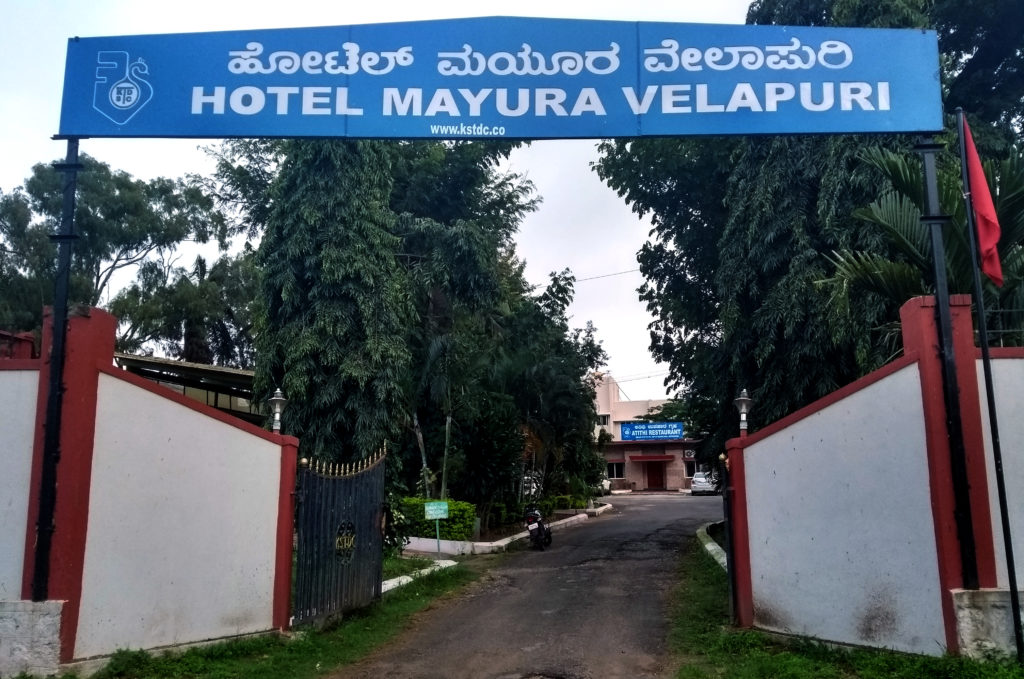
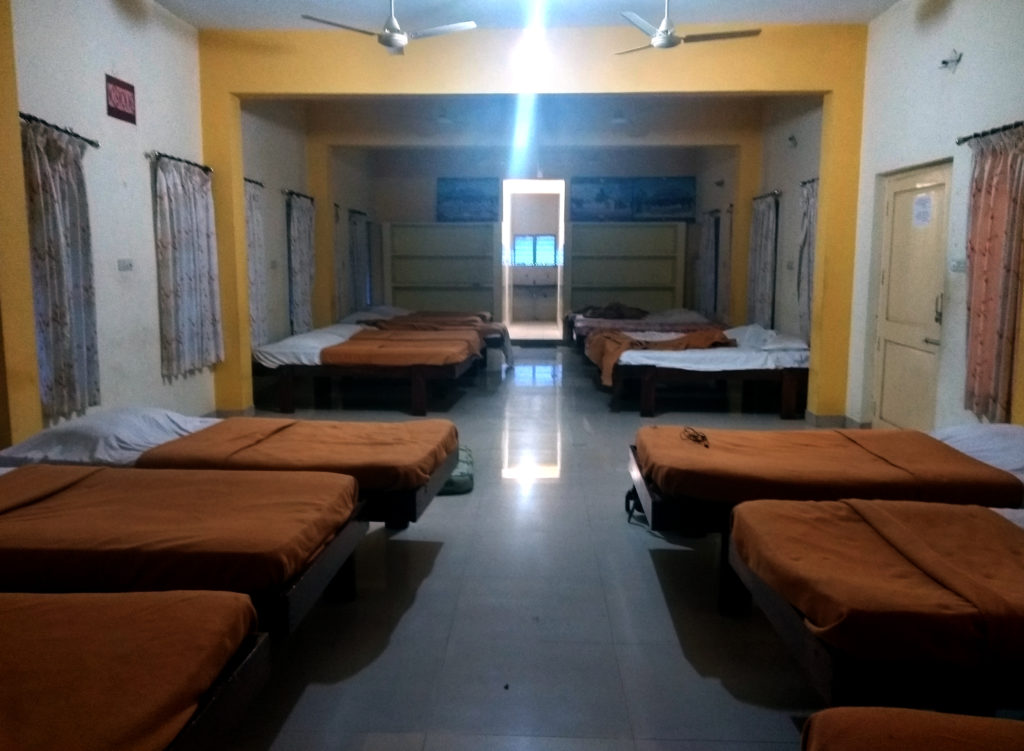
? There are several hotels nearby to stay in Belur, but the first choice is KSTDC Belur (Hotel Mayura Velapuri). The room charges range from 1599 to 3099 per night. They provide decent food options for breakfast, Lunch, and Dinner.
? They also have decent dormitories, Rs.250 per bed per night, which is a fun idea for a large family or solo travelers on a tight budget.
Book Belur KSTDC hotel here.
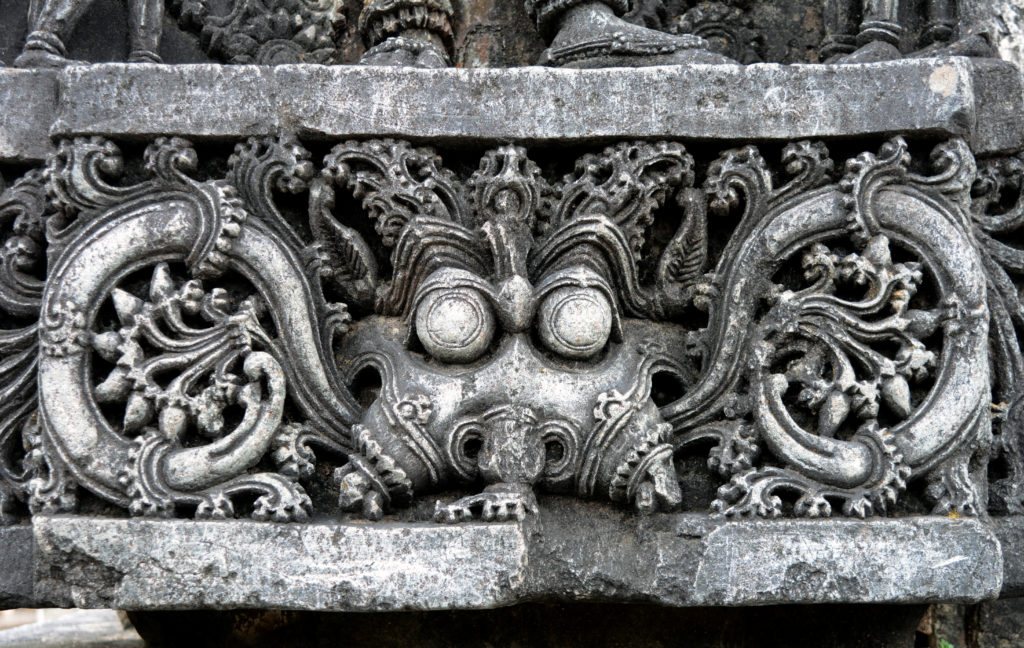
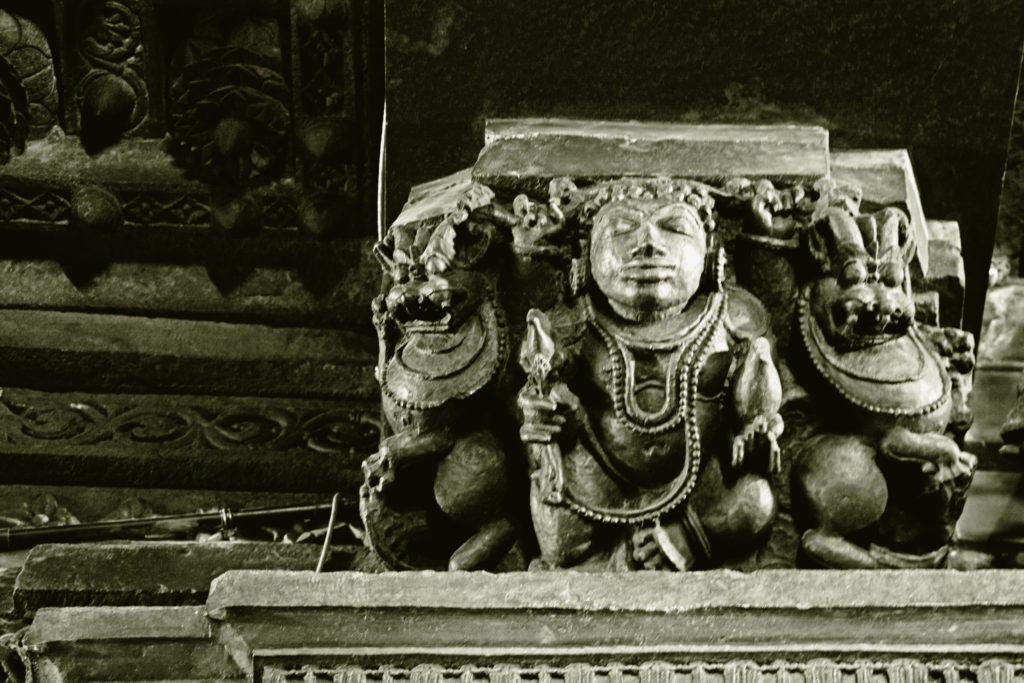

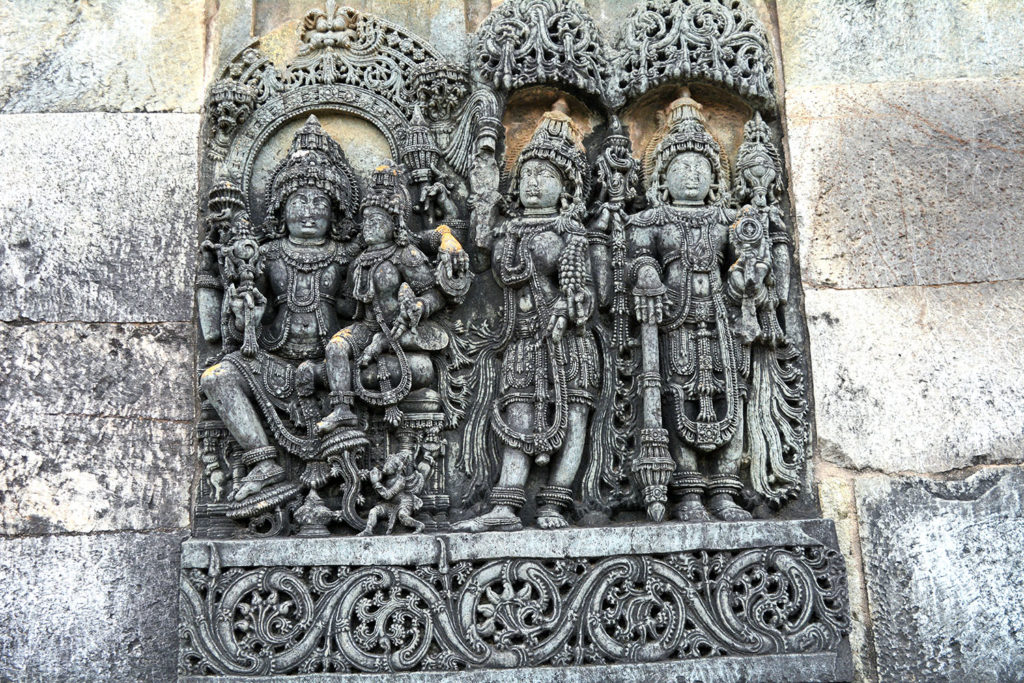
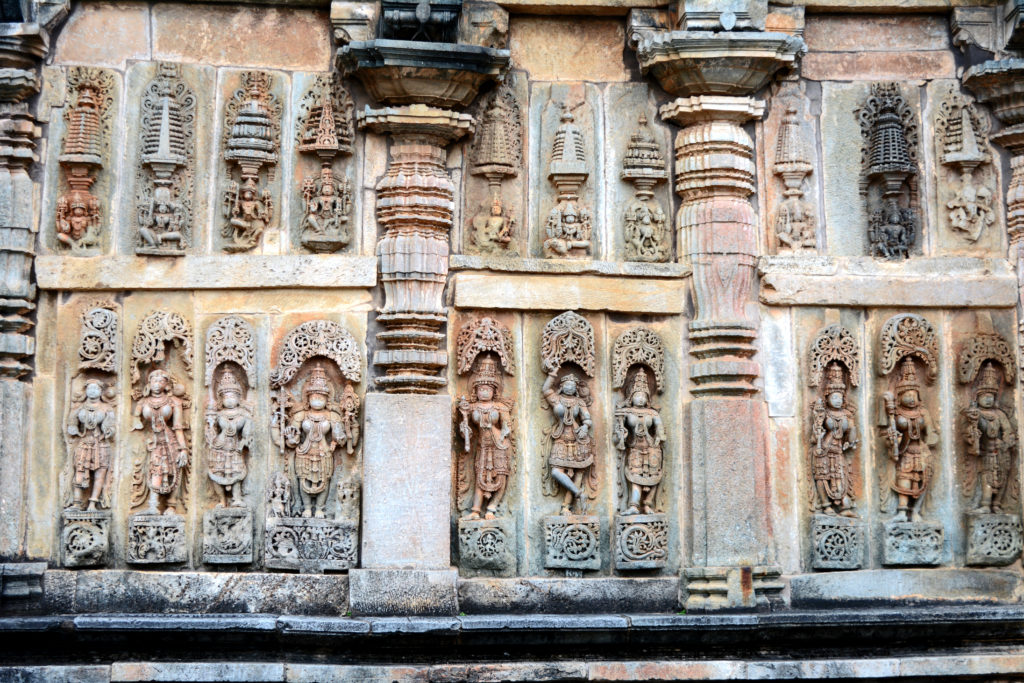
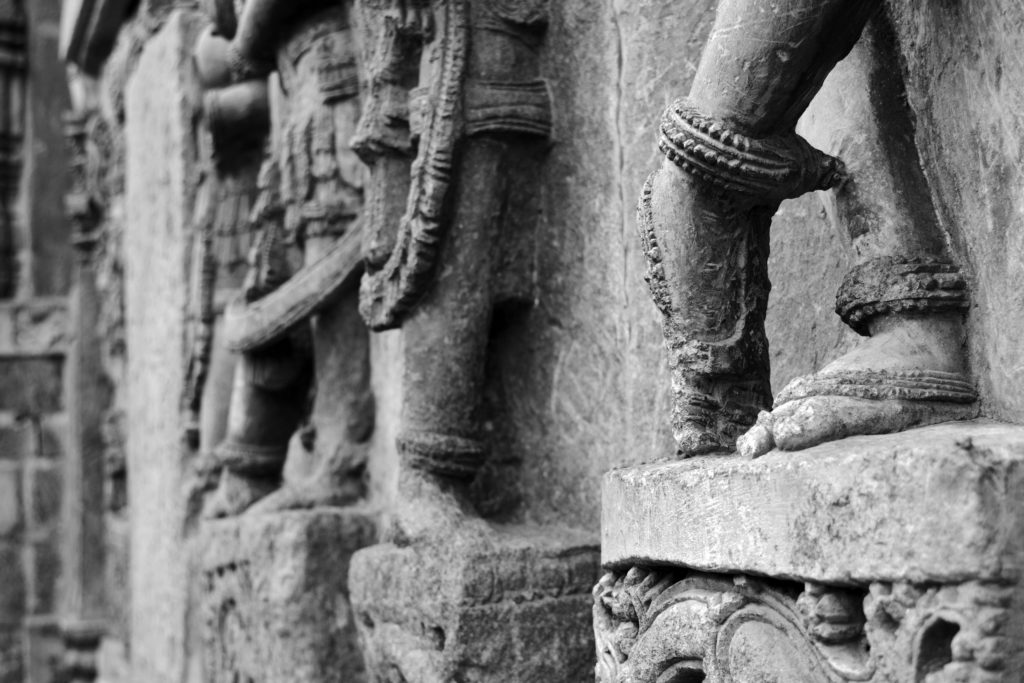
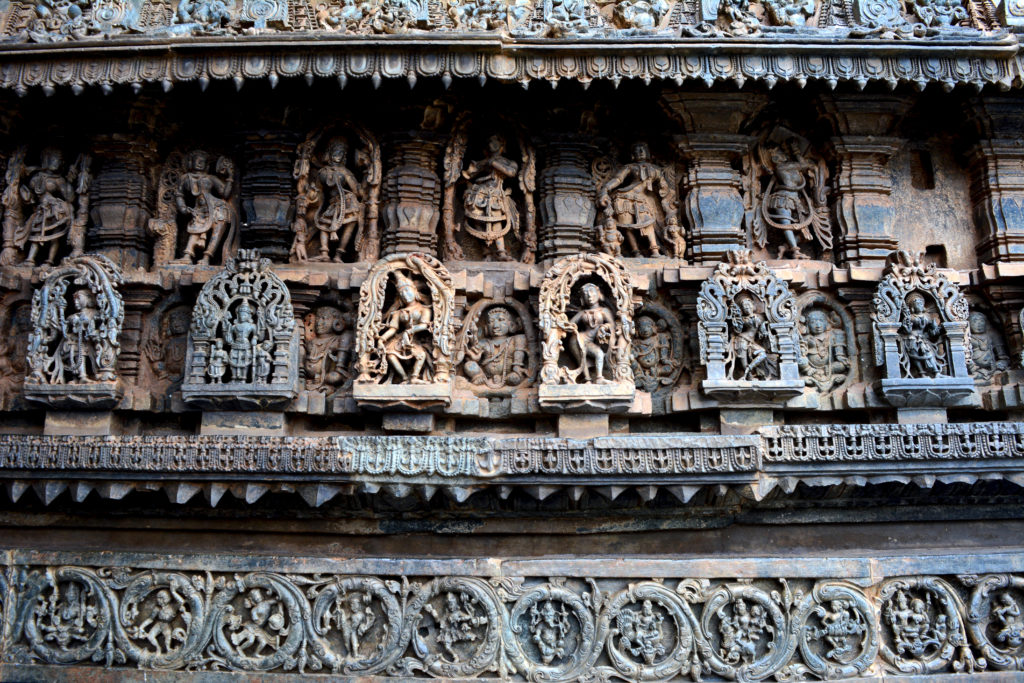
References:
1. History of Karnataka (History, Administration & Culture), by I. M. Muthanna, Published by Usha Press, Mysore City, 1962
2. Glories of Beluru and Halebeedu, by Dr. Neelkanth
Kote, Published by Dr. Neelkanth Kote.
3. Epigraphica Carnatica, by Benjamin Lewis Rice, Director of the Mysore Archaeological Department, 1894 to 1905, published by Rice, R. Narsimhachar.

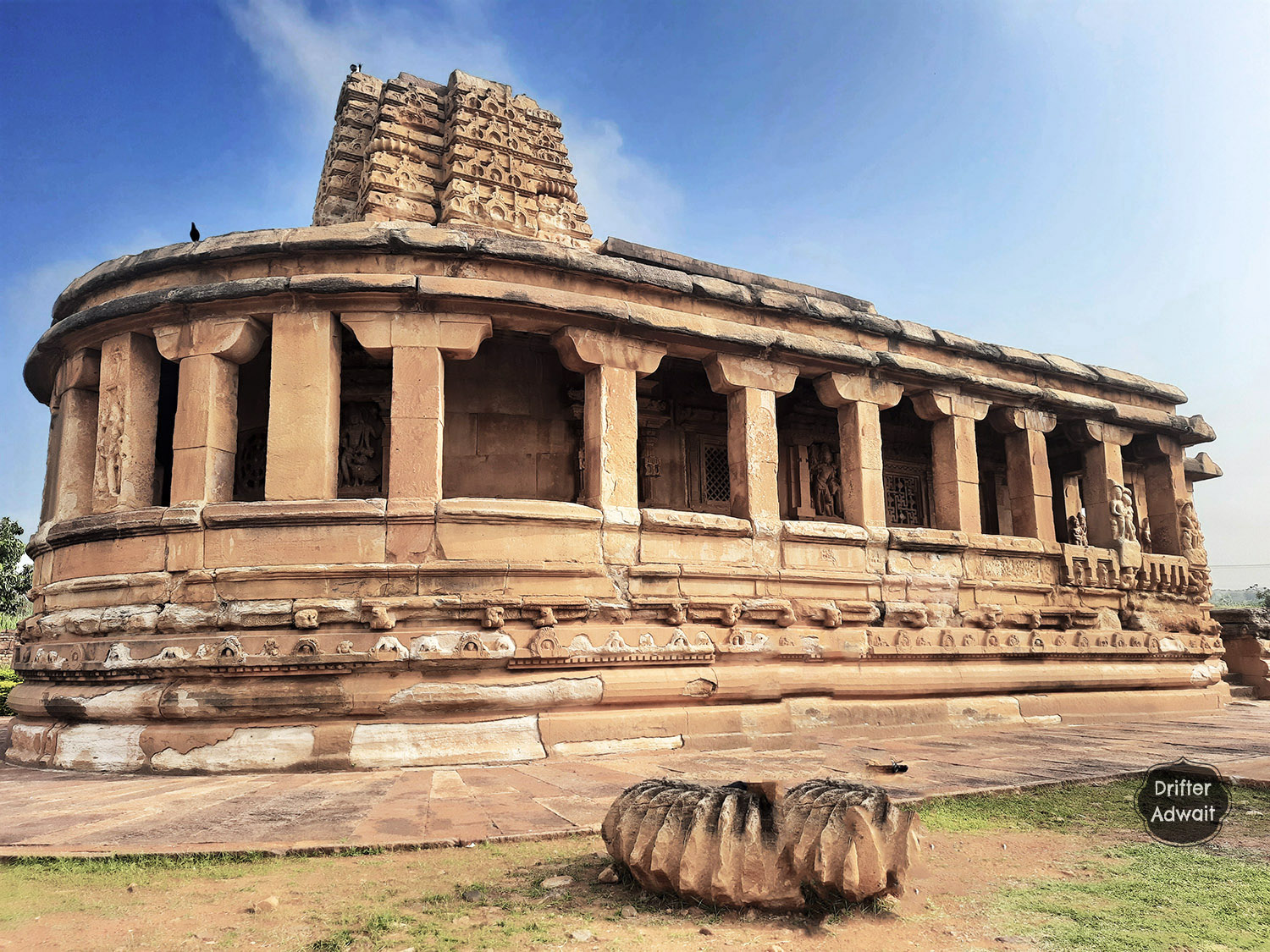
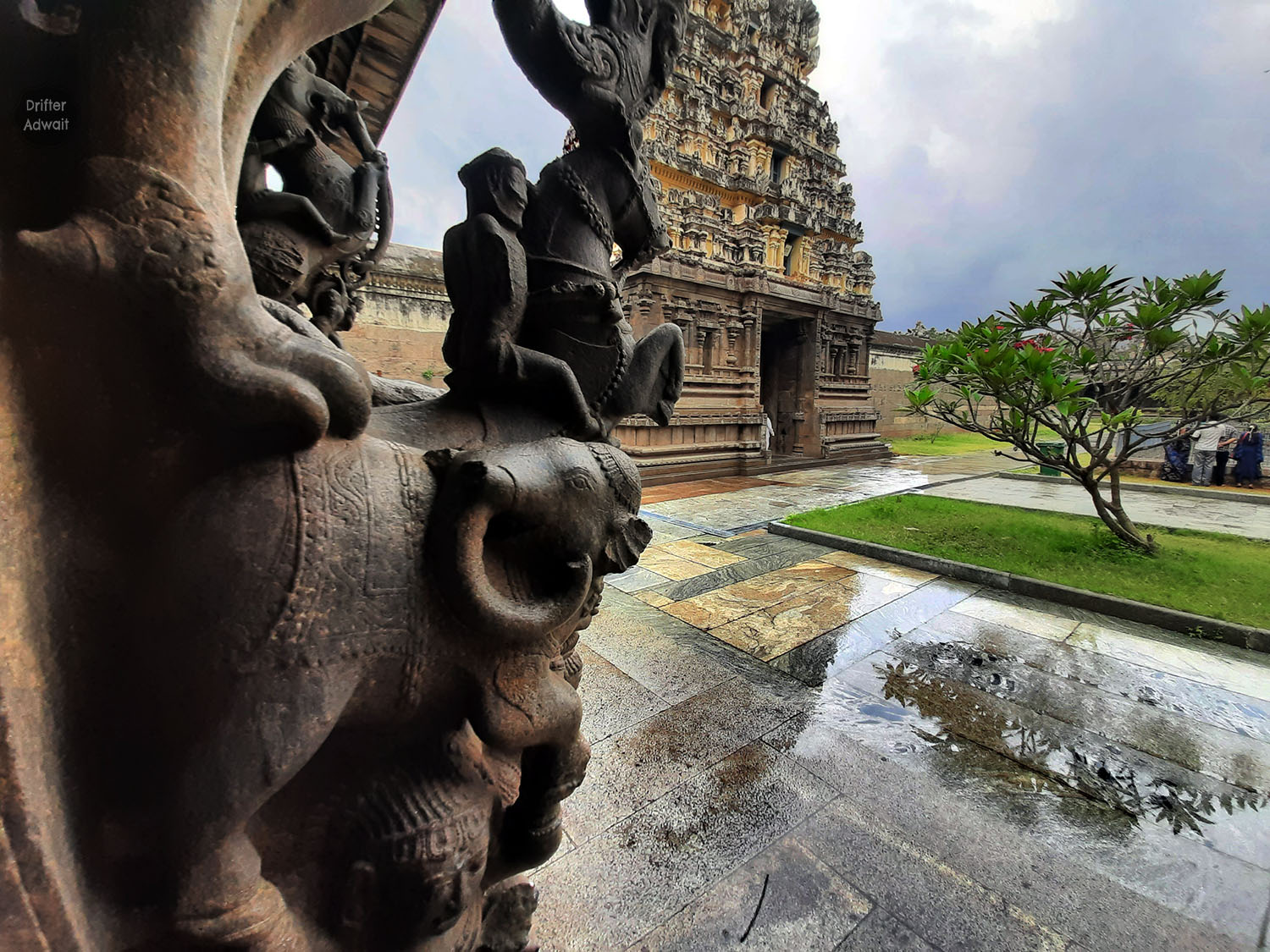
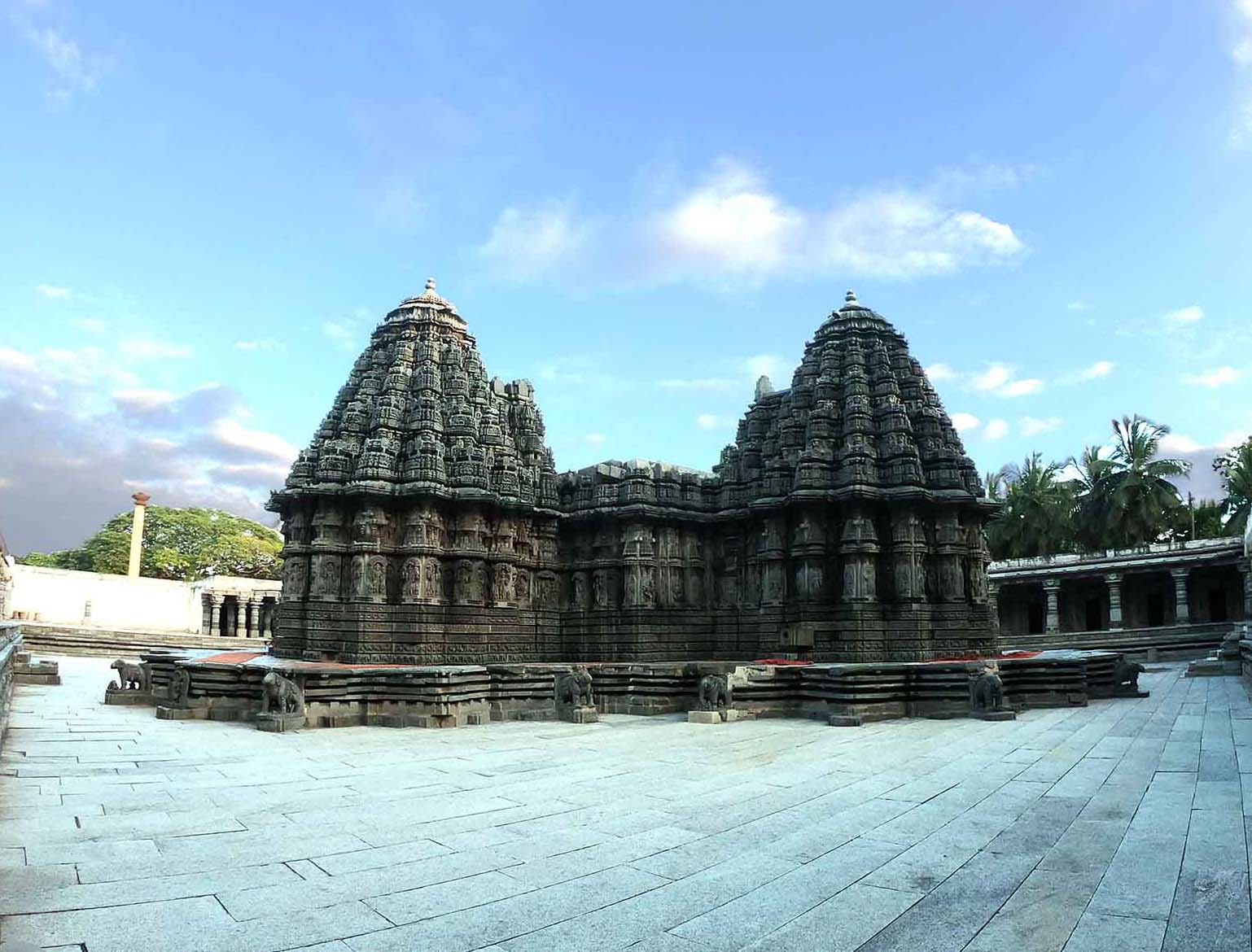
Such an interesting Blog. Lesser known stories of lady with donkey’s face accompanied with a Sanskrit sloka was very informative.
Rightly said. We need many visits to cover the site in deail. However you have made such an excellant post, available to all for more informed viewing. Thanks a lot
Namaskar Rajini Ji,
Thank you so much for your kind words and appreciation! I’m thrilled to hear that you found the story of that teenage couple interesting and informative. Your encouraging feedback motivates me to continue exploring and sharing unique stories. Your input is invaluable, and I’m always eager to visit the places , research and create blogs that resonates with readers like you.
Once again, thank you for taking the time to read and engage with my travel blog. Happy travels, and I hope you continue to enjoy the adventures shared on the platform!
Really very spectacular place
Spectacular Indeed. Thank you for visiting the blog Sir.
Super
It’s one of the best blog on Facebook I have ever seen.
Thanks for valuable information.
Dhanyawad Balaji Sir. It’s a beautiful heritage temple, our ancestors have gifted this to us. It’s our responsibility to take this forward.
Great information…nice photo…
Thank you Balasaheb.
Very well written with all information and photos. Anybody will love reading this blog.
Thank you for the thumbs up sir. Please visit this temple atleast once in lifetime. It’s our responsibility to let people know about our forgotten heritage.
Hi Adwait,
While just surfing up and down on Facebook, I came across this post. Happy to read it. Your writing, detailing and the photographs are very much appealing to visit the place. Keep writing.
Thank you for the kind words.I appreciate it.
Really Valuable information along with beautiful pictures. Keen to visit the place soon.
Thanks, Deepti. Please come to visit, there are plenty of such ancient temples to explore here. Halebeedu is 25 KMs from there.